I’ve been wanting to explore the Gower Peninsula for some time, so when deciding where to go for our early summer holiday, I convinced my family that South Wales should be our destination this year. I was curious to explore a big city like Swansea and to take in the inspiring scenery nearby that I’d seen so many times on the web and social media.
The Gower Peninsula was designated as an Area of Outstanding Natural Beauty in 1956 (now renamed a National Landscape), the first in the UK to receive this title, because of its limestone coast and rich, diverse natural habitat. Today, it is part of a family of 60 areas that are protected in England, Wales and Northern Ireland.
We stayed six nights in The Mumbles, an ideal base right on the border between Swansea’s district and the Gower, giving us plenty of time to explore the most sought-after locations, as well as discover a few hidden gems. The weather was mostly cooperative and, leaving in late July, the first week of the summer half-term meant the area was not overcrowded yet.
This article is an account of all the things we did as a family of five (two parents, two grandparents and a lively five-year-old), as well as a few things we missed (a great excuse to go back someday!), together with practical information that will hopefully help you when planning a similar trip.

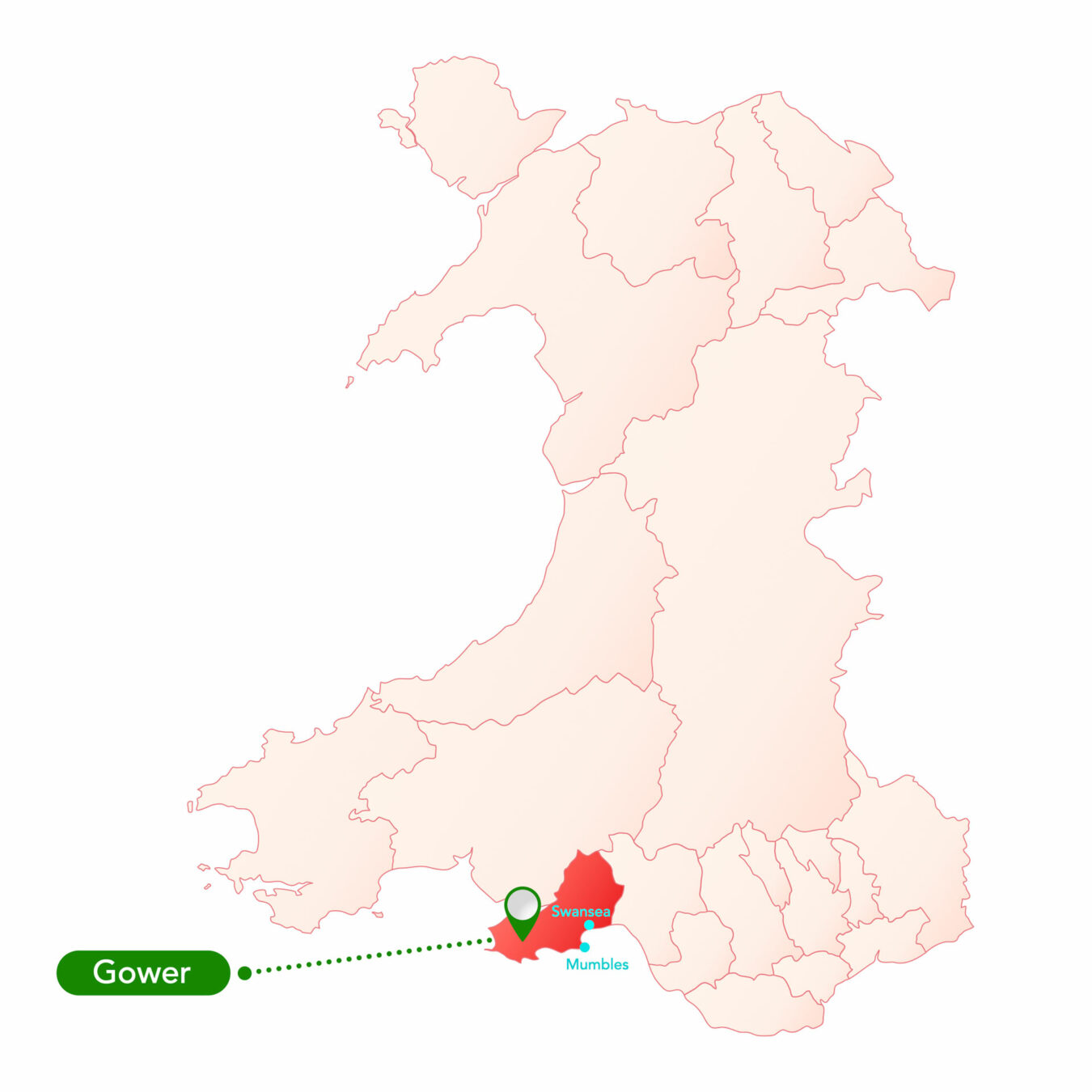
The Mumbles – Our Base for the Week
We rented a lovely little cottage in The Mumbles, a district located to the south-west of Swansea and named after the headland on the south-east corner. It’s a very popular destination thanks to its long promenade, numerous shops, cafés and restaurants, as well as its ideal geographical position at the start of the Gower Peninsula coastline, while still being close to a large urban area. It’s the perfect place from which to start exploring.
There is plenty to do in The Mumbles, so the town itself is well worth of your time. There’s the two-mile-long promenade where you can also catch the Swansea Bay Rider land train, which runs from Blackpill (north of The Mumbles) — something your little ones might especially enjoy if they’re into trains, as my son is! Speaking of children, there’s a lovely playground along the promenade, which was being refurbished and expanded during our stay — so it should look even better by the time you visit.

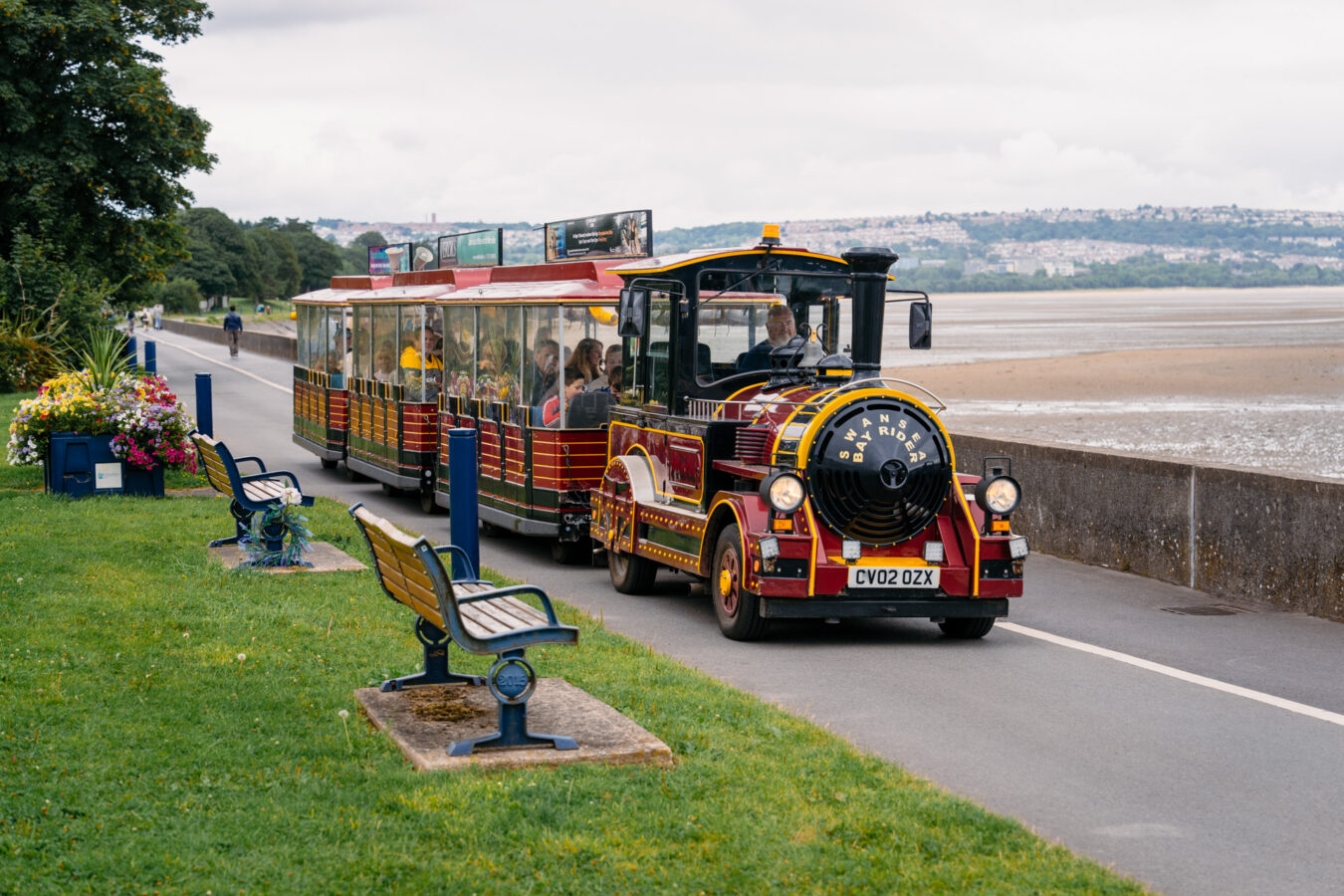
Historic sites worth visiting include Oystermouth Castle, which offers breathtaking views of the coast, and the Mumbles Lighthouse. There’s the pier, the big wheel, the beautiful Clyne Gardens and a variety of walks you can take to explore the nearby bays. It’s also a great spot for watersports, and you’ll often see both adults and children heading out with their sailing boats on a daily basis.
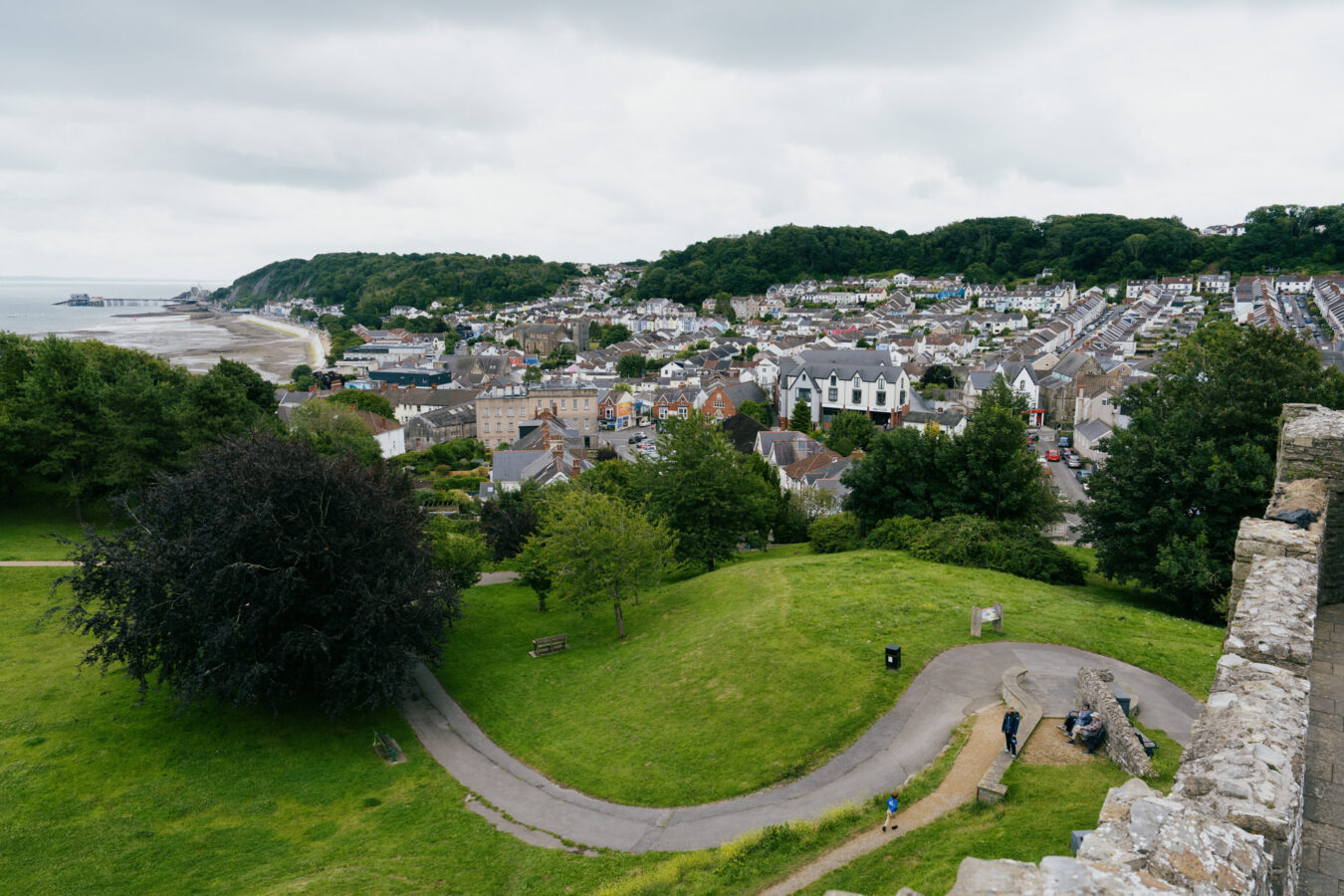
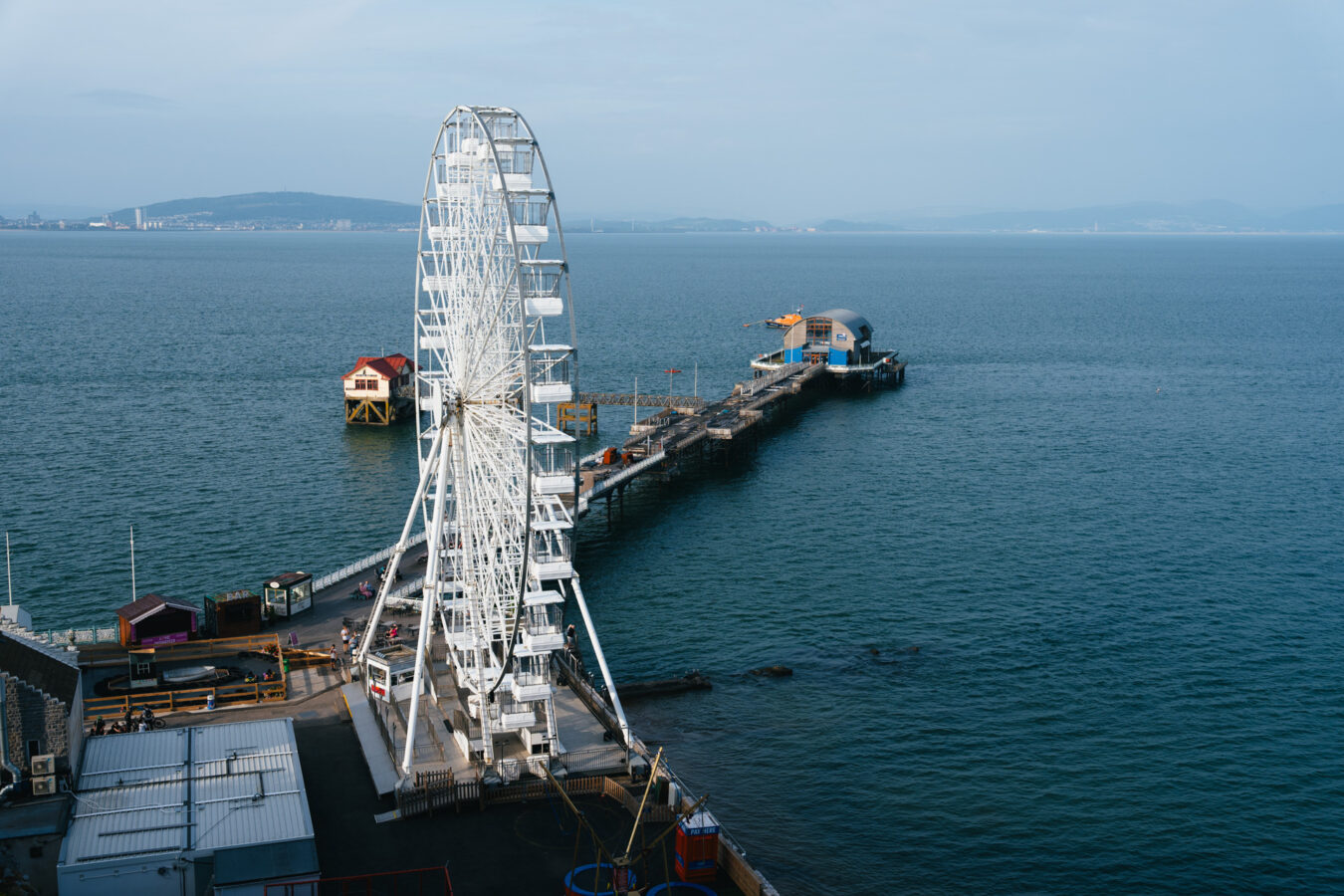
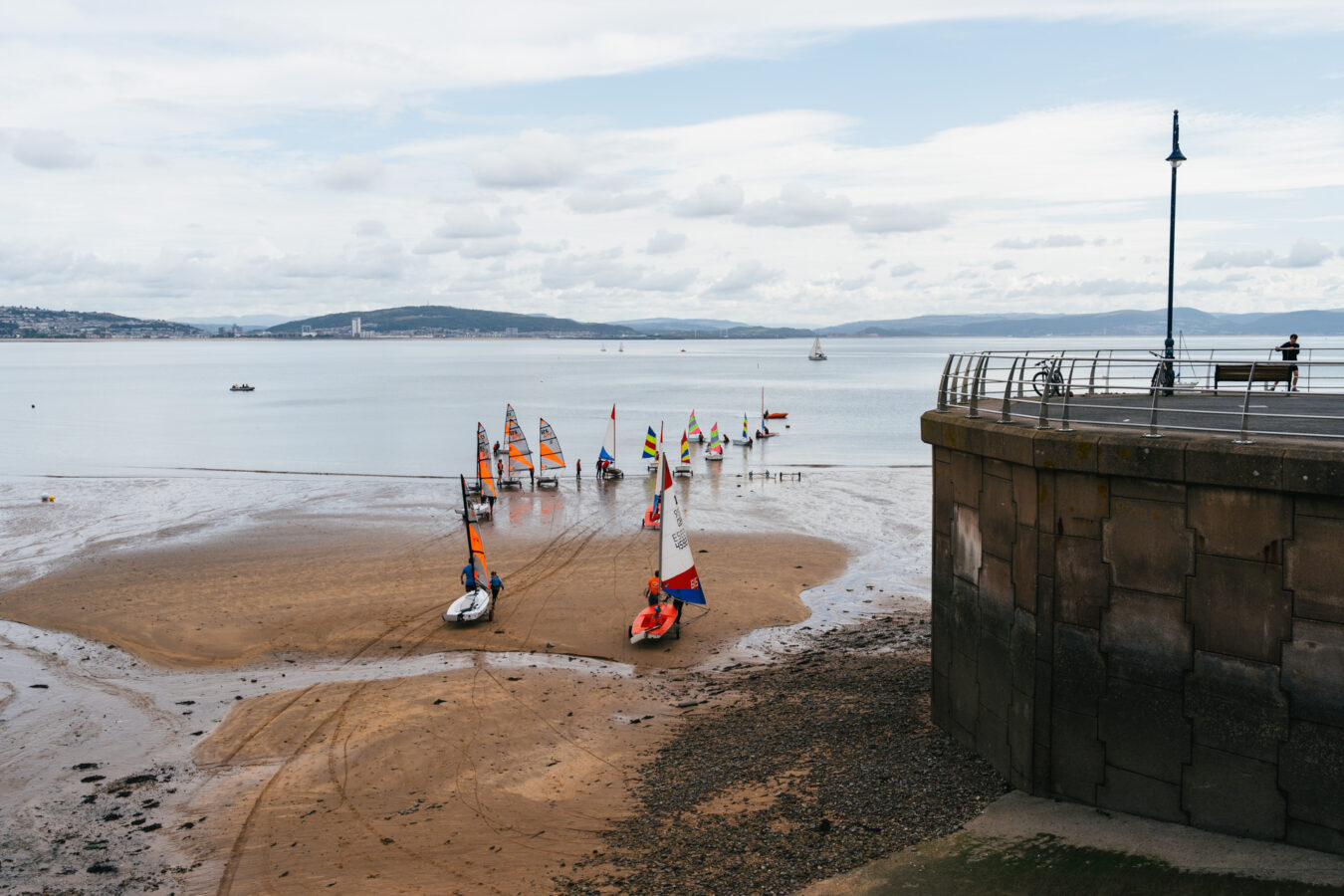

But perhaps the best thing about The Mumbles is just how easy it is to live in. It’s not too big, yet it has all the shops and amenities you could possibly need. You’ll find a large variety of cafés and restaurants serving fresh food. We had excellent meals at Nishimura Japanese Restaurant and at Papi’s Pizzeria, which serves surprisingly authentic Neapolitan pizza. If you fancy some ice cream, try Verdi’s, near the Yacht Club.
It’s also worth exploring some of the streets away from the seafront to discover the many independent coffee shops — with a special mention for Mumbles Café (the croissants are to die for) and Boo’s (excellent coffee and a great breakfast).
useful info about THE MUMBLES
See Mumbles on
Google Maps | Apple Maps
Parking: Most car parks are located along the promenade at the front, but they are not very large and tend to fill up quickly on busy summer days. Some allow 24-hour parking, but make sure to check the signs carefully.
EV charging stations: There are a few slow chargers in town, at the Knab Rock car park next to the yacht club, and at the 24-hour Pay and Display car park near the roundabout downtown. If you need a fast charger, there are four 60kW units by the Beaufort Arms pub in Kittle, about 10 minutes away. That’s the option I went for on our last evening — I charged for about an hour while my father-in-law and I enjoyed a pint outdoors. You could also time it with an evening meal.
Public transport: There are no train lines, but buses between The Mumbles and Swansea run three times per hour every day. Services also go to Bracelet Bay and Langland Bay. (See extra information at the bottom of the article.)
Day One – Swansea
The only bad weather was forecast for our first full day in the south, so we decided to explore Swansea (Welsh name Abertawe), thinking the second-largest city in Wales would provide more shelter and indoor activities if it started pouring.
After parking, we headed towards the centre, where there are some pedestrian streets, and had a look around before making our way into the Indoor Market — one of the highlights of things to do in the city. It’s award-winning and the largest indoor market in Wales, offering an impressive selection of fresh local produce, street food, antiques and bespoke gifts. There’s a pleasant seating area right in the middle where you can have lunch, a coffee, or simply relax. It’s a lively hub that often hosts events with live music and demonstrations.
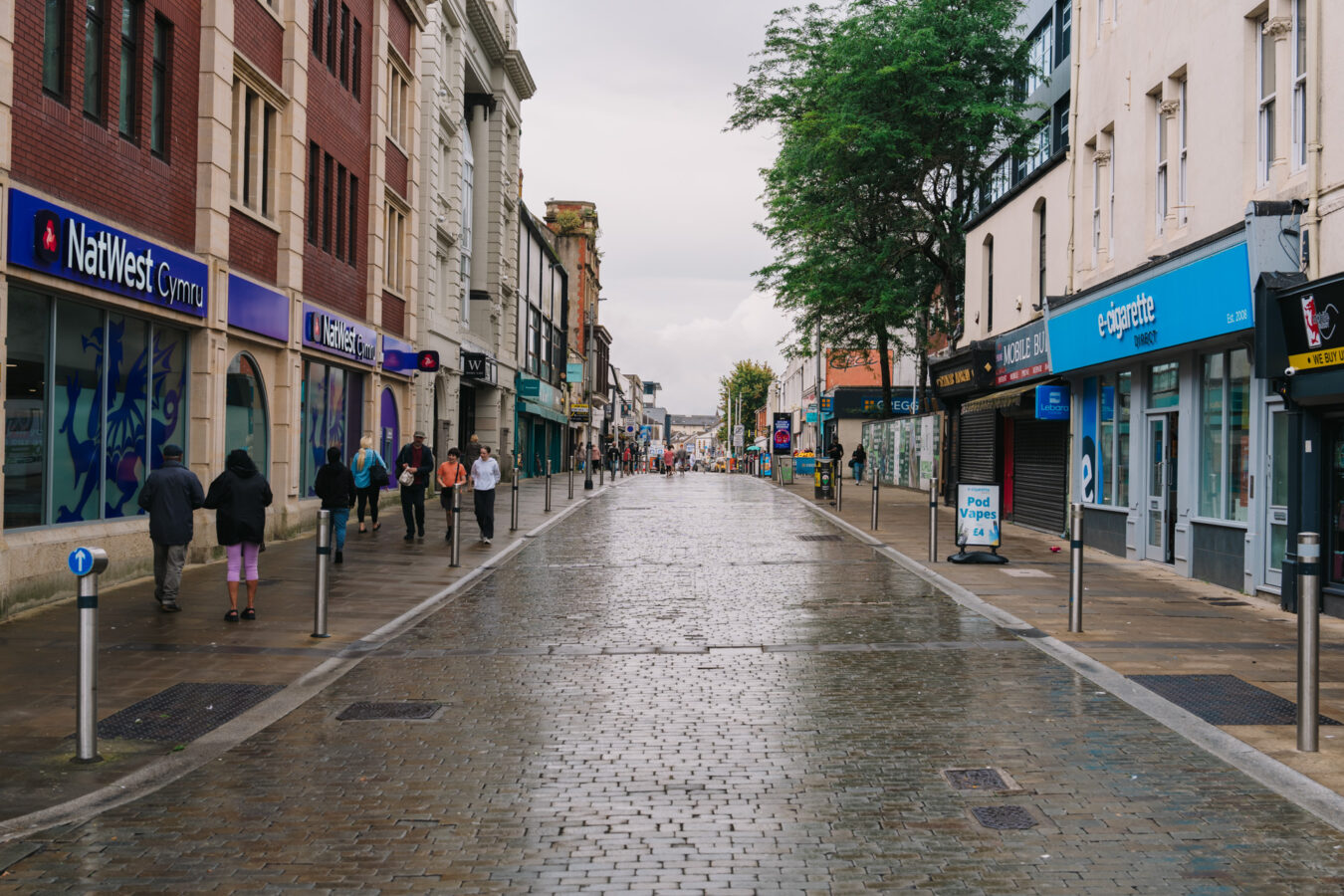
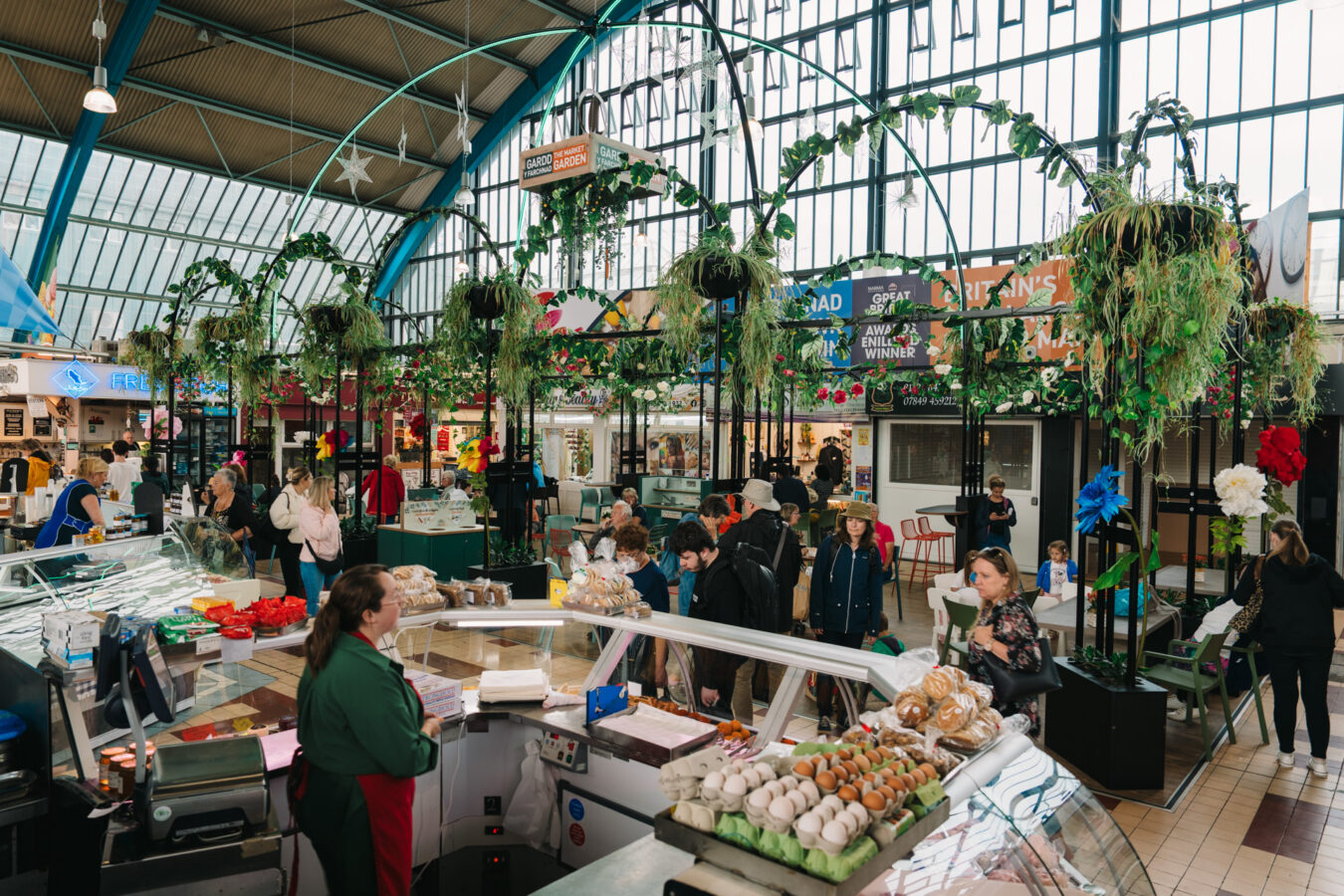
After the market, we went outside, taking advantage of a relatively dry morning so far, to visit Swansea Castle. There isn’t much left, but the ruins are a testament to what was once a great fortress of strategic importance, overseeing the harbour and the east–west route along South Wales. The remains contrast sharply with the modern buildings around them, creating an interesting visual blend of past and present.

Heading for lunch, we walked past buildings with splashes of colour, revealing a city that felt much more vibrant than our grey, cloudy day would suggest.
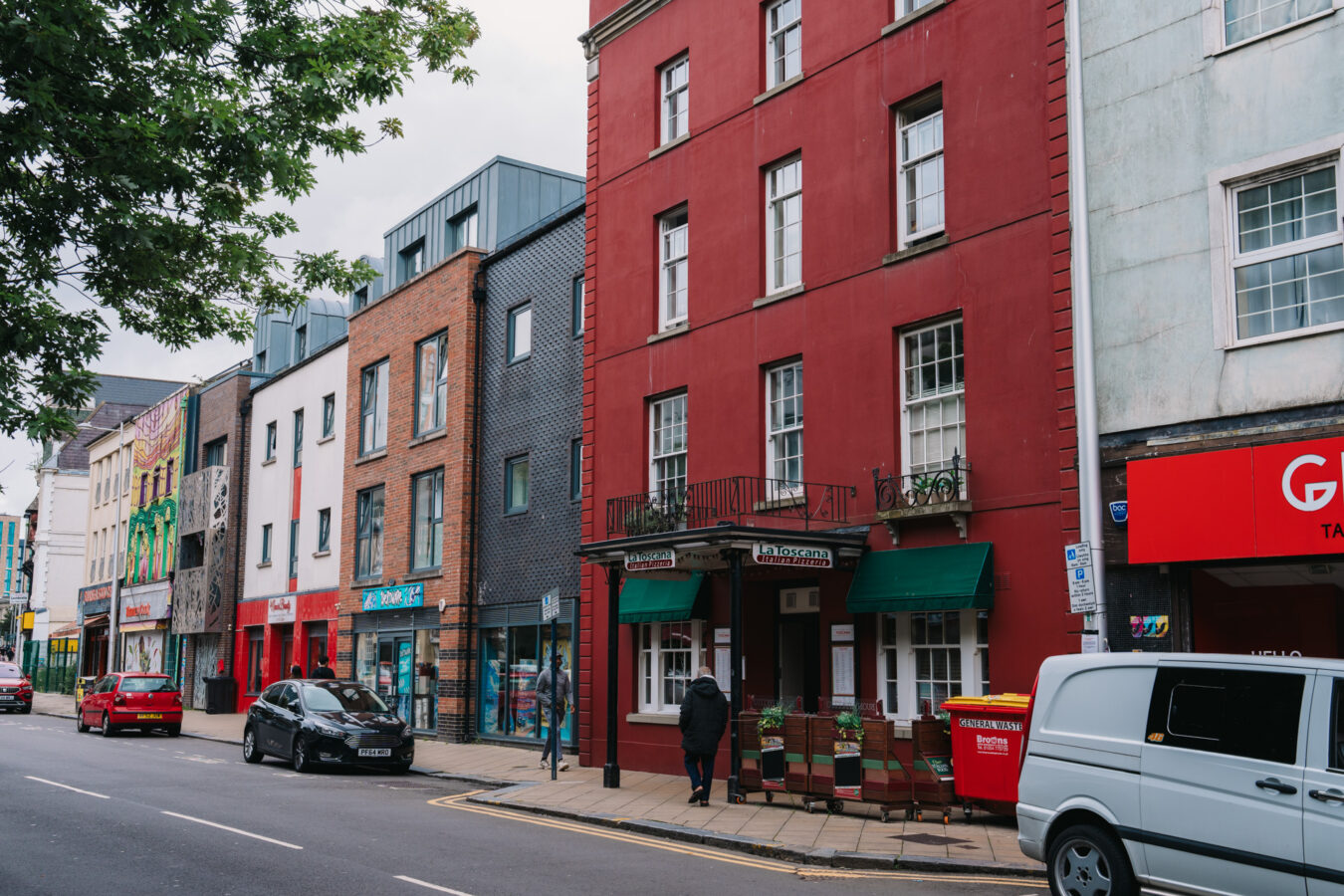
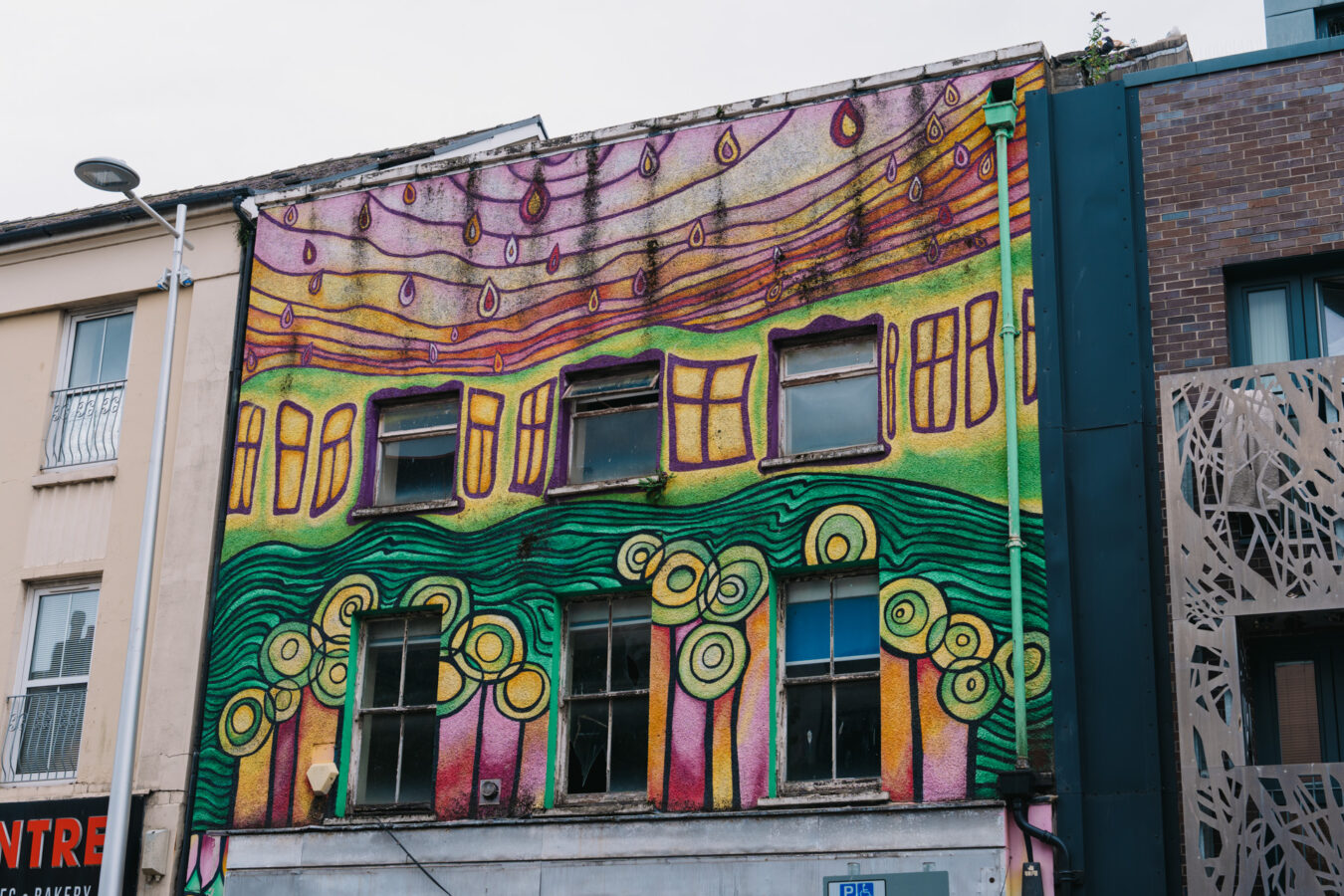
After a fantastic meal at Turkish Kitchen — with very generous portions and everything freshly cooked — we wandered towards what seems to be the most modern part of Swansea. The highlight here is without doubt the Copr Bay Bridge, a striking new pedestrian and cyclist bridge across Oystermouth Road, its golden colour visible from miles away. It sits next to the Swansea Arena, also coated in gold, along with the stairs and other architectural elements. It’s certainly a bold take on modern architecture, although not every resident is fond of it — nicknames include “Cornish pastie”, “fortune cookie” and “chunk of cheese”.




As the rain began to fall heavily, we headed towards the maritime quarter to visit the National Waterfront Museum, an engaging interactive space telling the story of industry and innovation in Wales over the last 300 years. Admission is free, so don’t miss the opportunity!
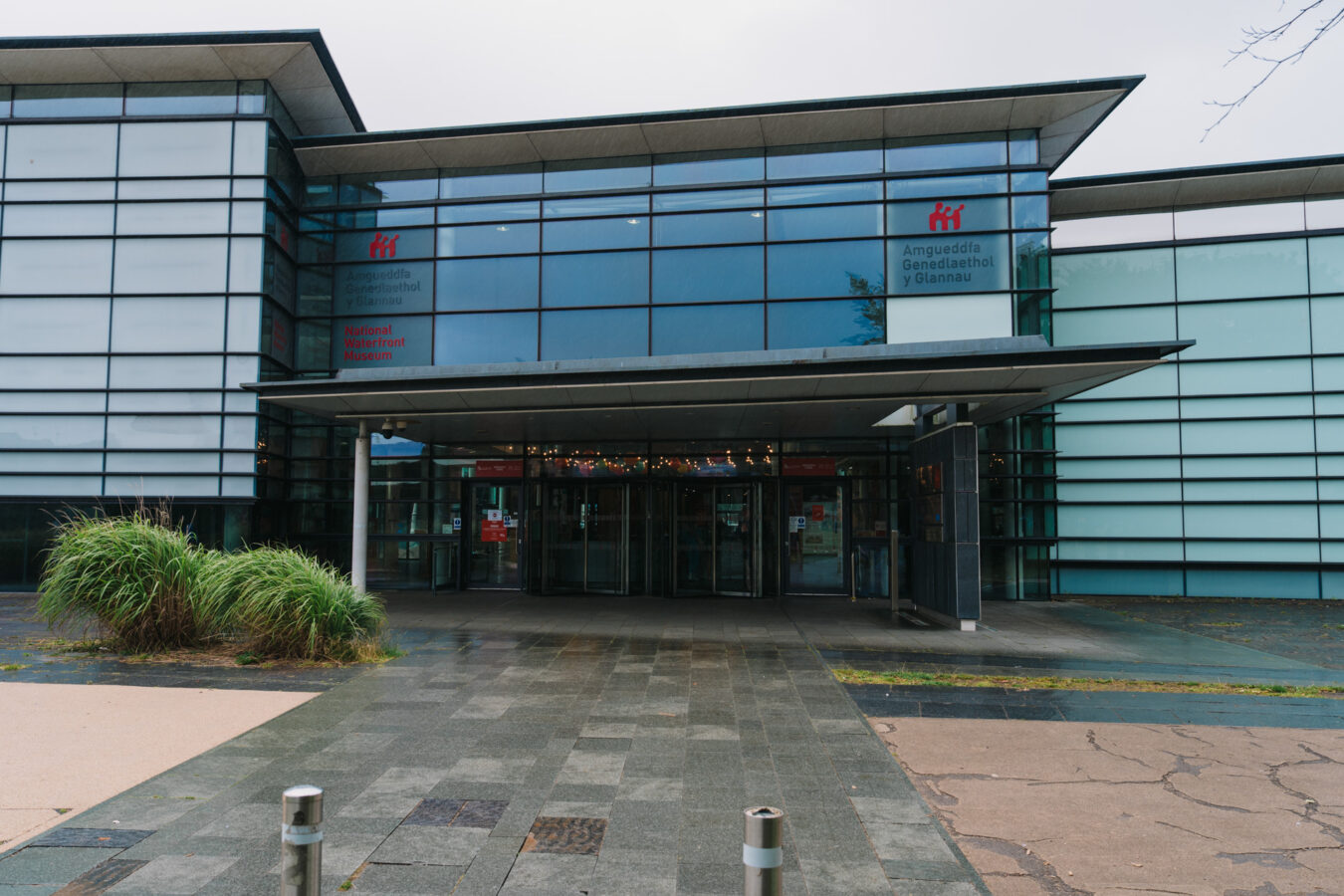
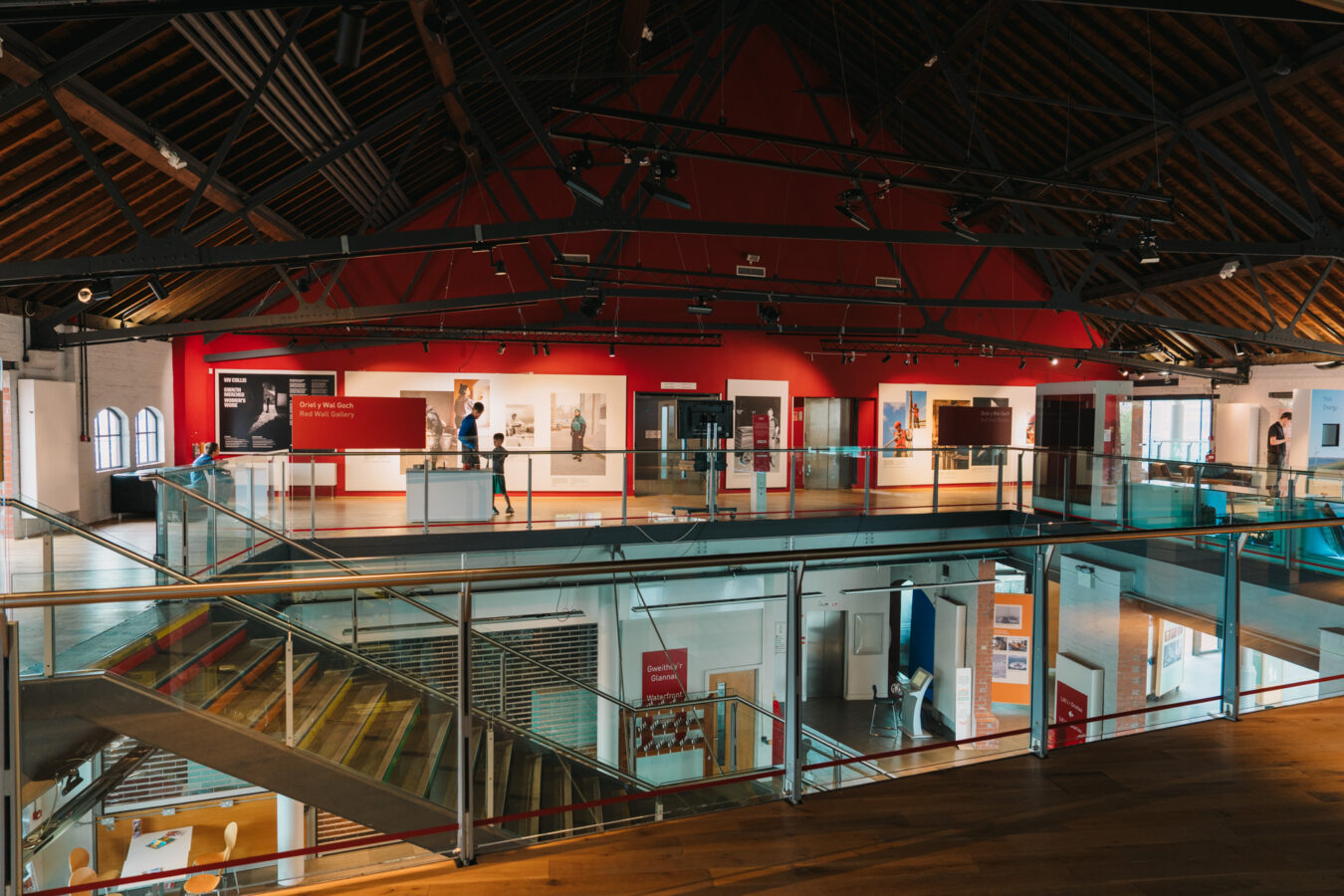
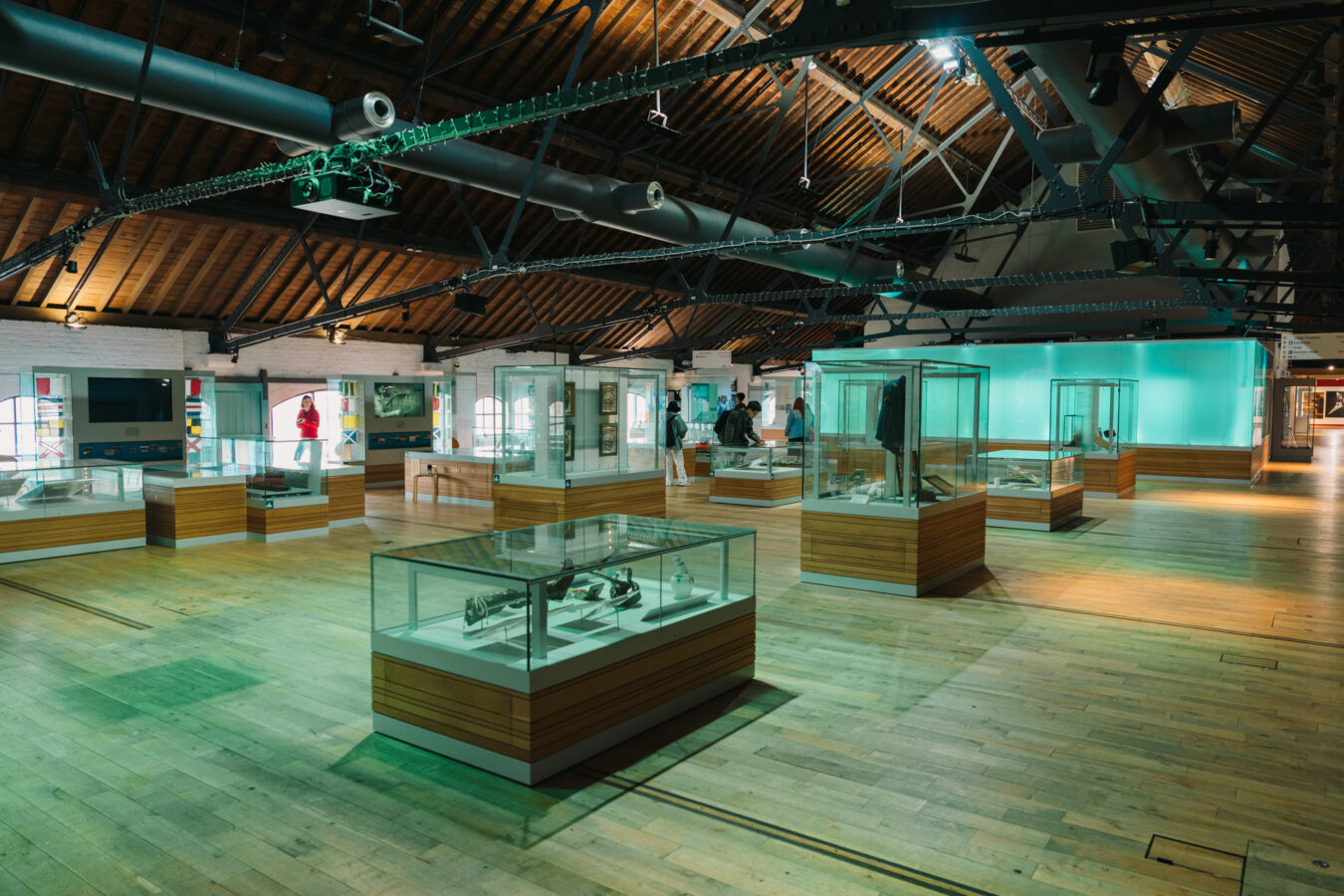
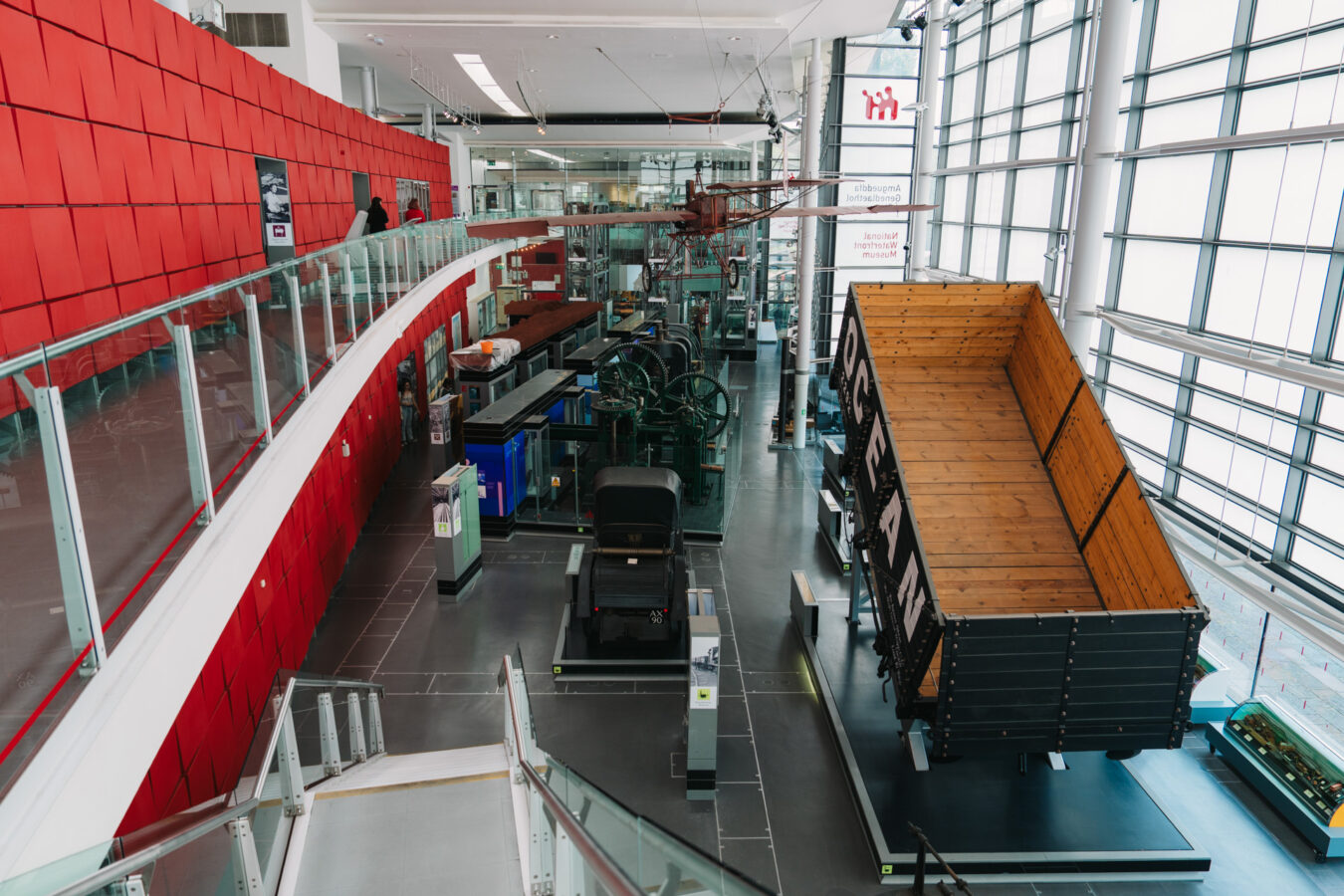
By the end of our visit, we were getting tired and my son clearly had enough, so we drove back to our base in The Mumbles. We didn’t manage to explore the marina around the museum, which is said to boast some interesting places to eat or have a drink — a good excuse to return on a sunny day!
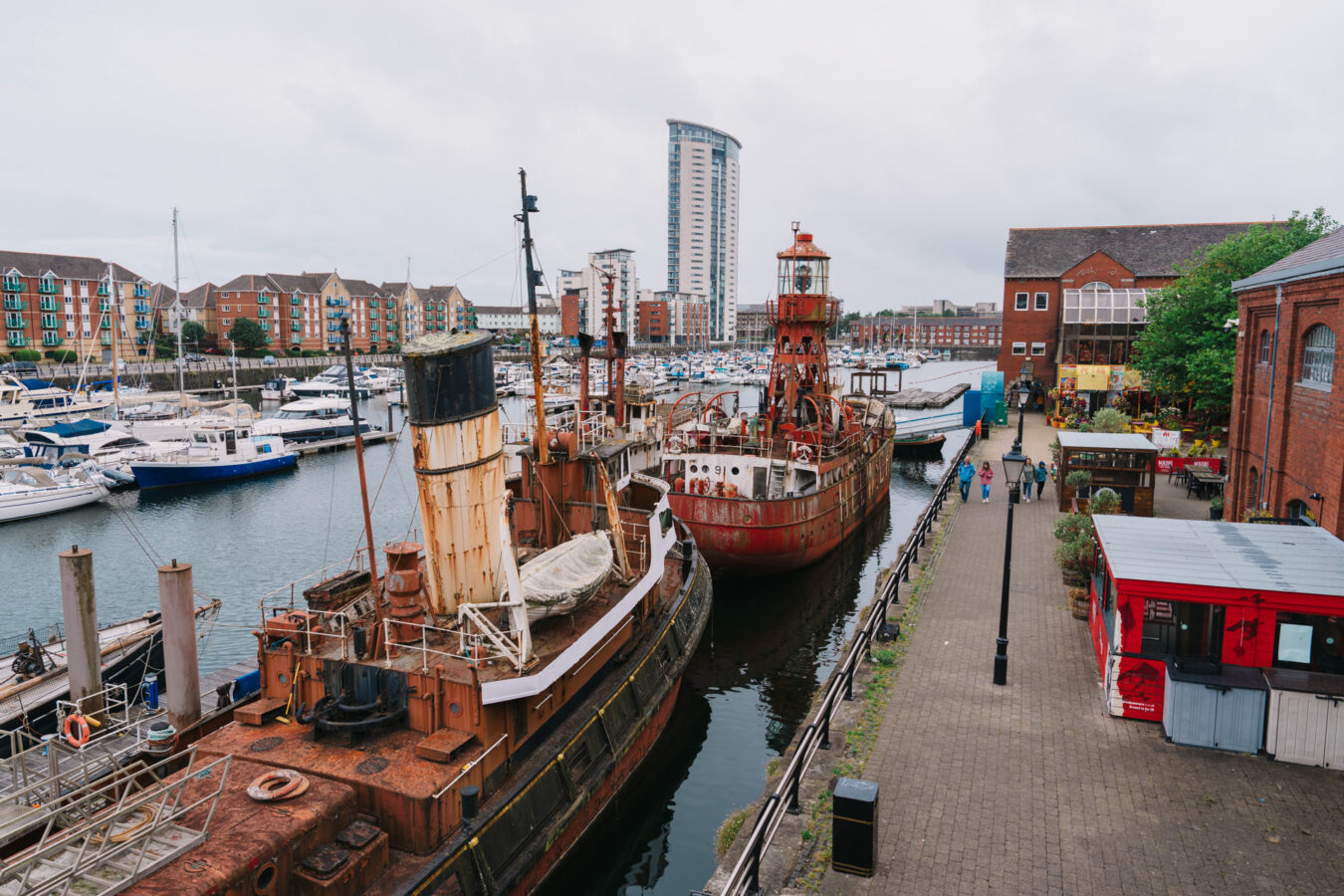
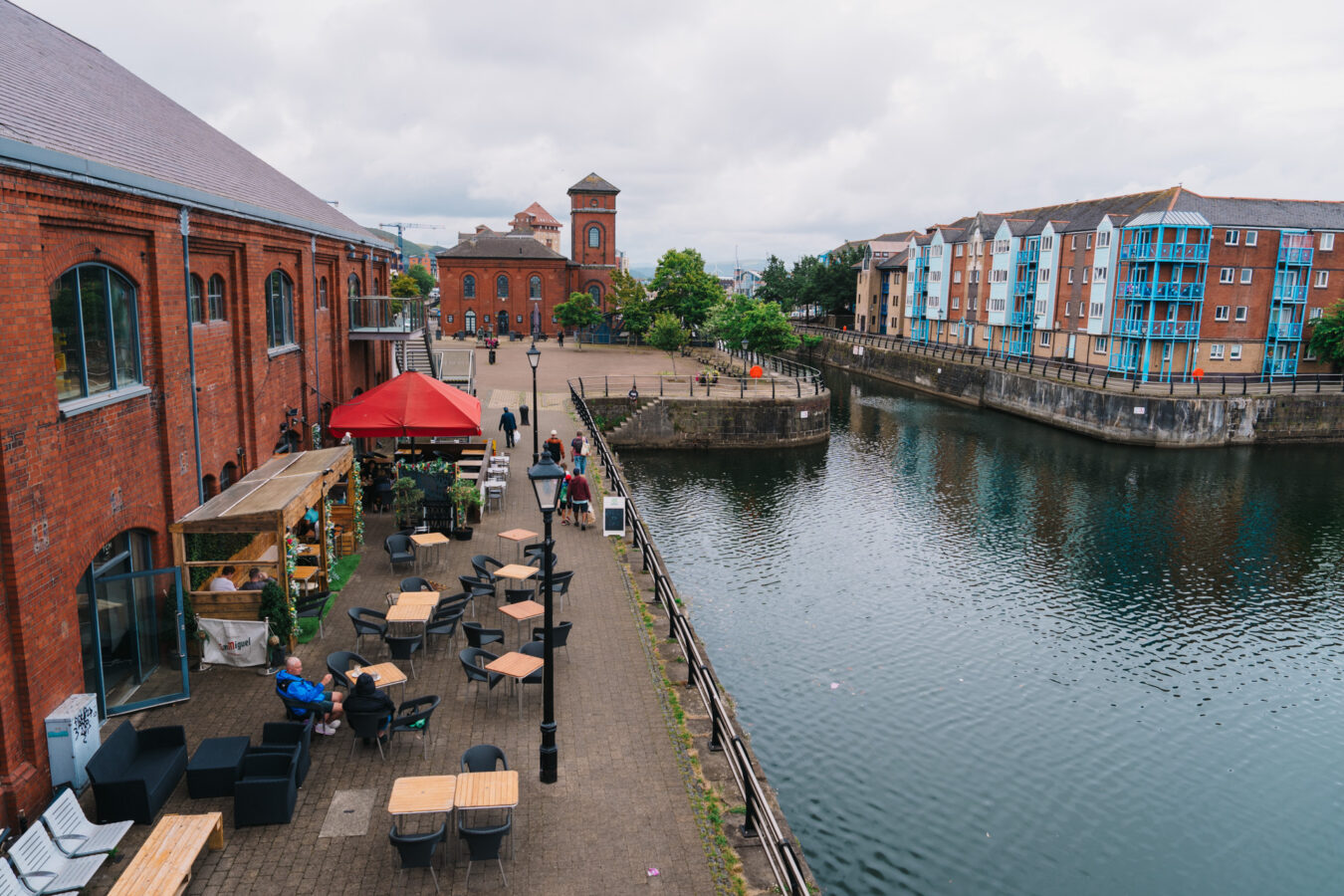
Despite the uncooperative weather, Swansea left me with a very positive impression, though also with the sense of a city in transition. It’s moving from its industrial past, rooted in 19th-century copper smelting, towards a modern, young and vibrant identity. With plenty of construction works under way, you can see it being transformed. I can imagine it becoming a brilliant place to visit again — and perhaps to stay — in just a few years.
useful info about swansea
See Swansea City Centre on
Google Maps | Apple Maps
Parking: There are several car parks in the centre. We opted for the NCP Kingsway multi-storey car park (you can pay at the machine or with the mobile app).
EV charging stations: Several Clenergy stations are available around the city centre, although do bear in mind that they are all 22kW chargers.
Public transport: Swansea railway station offers frequent direct connections to the capital, Cardiff, and to other major cities in the south such as Newport. There are also direct services to Carmarthen, Pembrokeshire (including Tenby and Fishguard), and northwards to Shrewsbury and all the way to Manchester. Various local buses will also take you to nearby areas, including many of the top spots on the Gower.
Other places to visit: Swansea was the birthplace of Dylan Thomas, Wales’ most renowned poet and writer, so you may be interested in the Dylan Thomas Centre. You can also visit the Edwardian house where he wrote many of his poems. The Egypt Centre, which houses the largest collection of Egyptian antiquities in Wales, is also worth a stop (admission is free). Finally, Swansea is a major hub for theatre and the arts, with regular shows hosted at the Grand Theatre and the Arena.
Day 2 – More Mumbles and Walking to Langland Bay
For our second full day, we decided to give The Mumbles some quality time. Walking down from the cottage, we stumbled upon an inviting independent café called Boo’s Kitchen, which proved an ideal stop for coffee and breakfast. We were impressed by the relaxed atmosphere and the quality of what we ordered, and immediately knew we’d be back (and we were — two more times!).

Next, we headed towards the 12th-century Oystermouth Castle, perched on a forty-foot-high limestone ridge overlooking the town. It’s a fantastic spot for breathtaking views of the bay and the photo opportunities that come with them. The castle has a rich history, and the very friendly staff are always happy to chat and answer questions. Entry costs £6 and the site is open from early April to the end of September (weekends only in October).

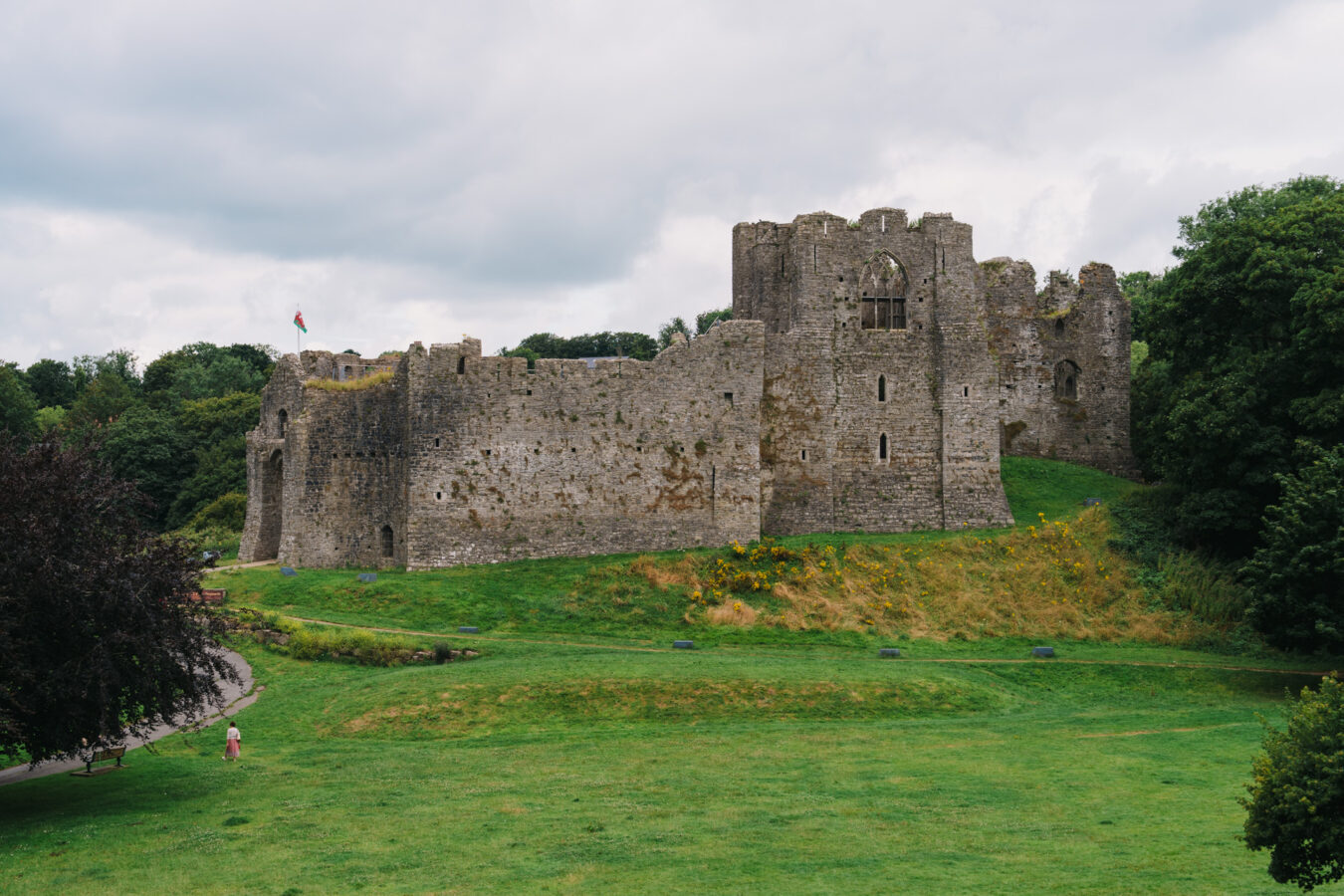
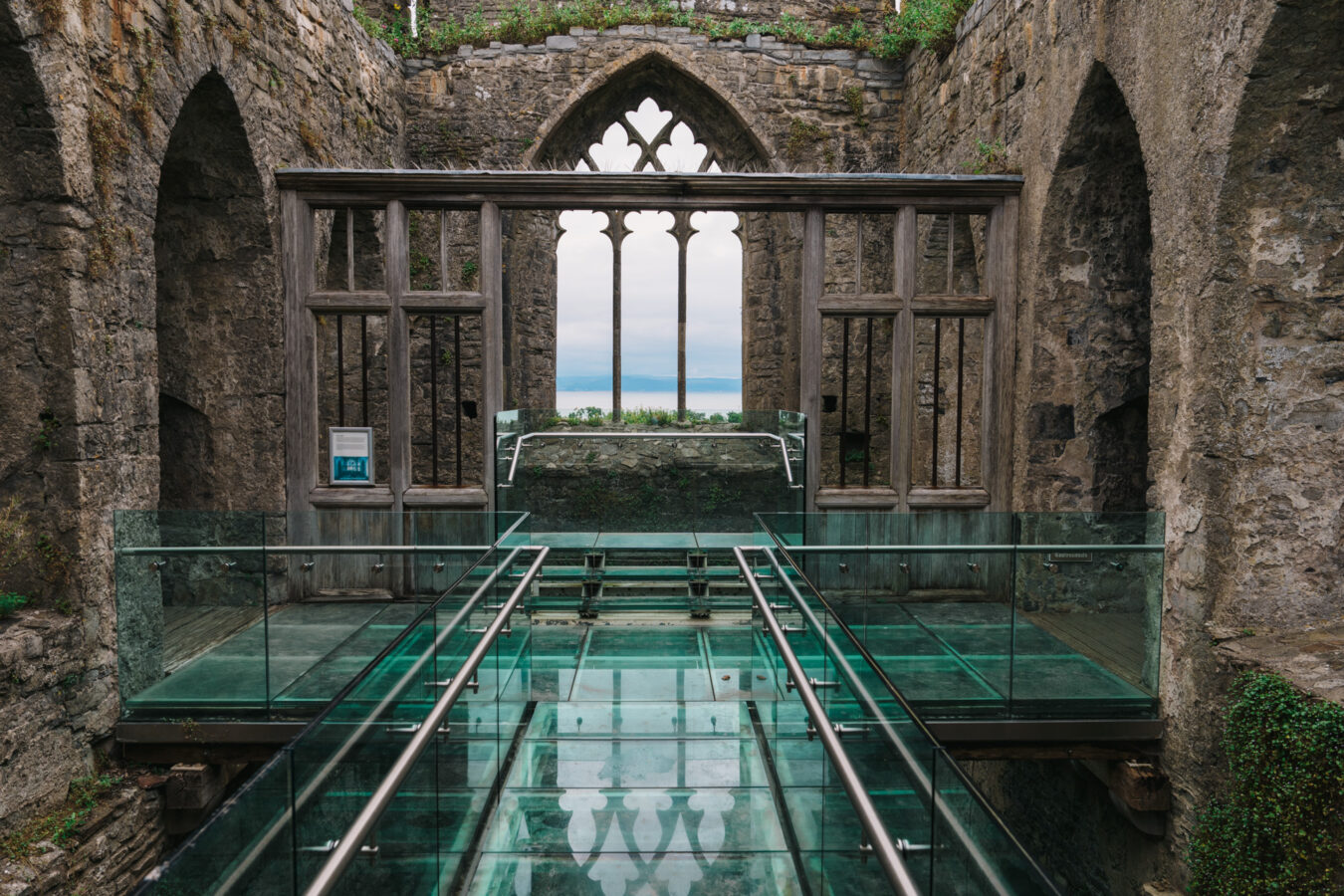
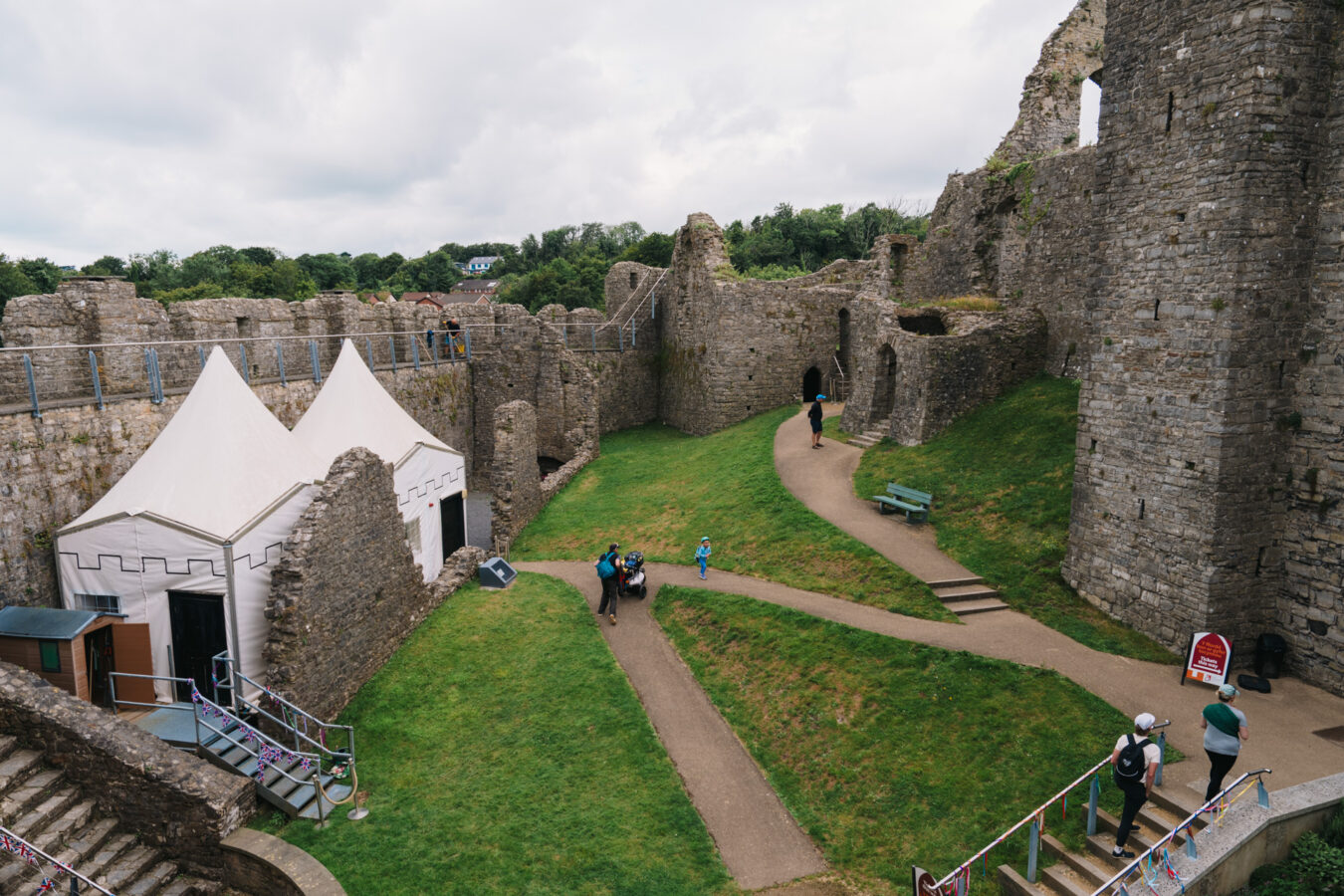
In the afternoon, we walked past the pier to reach Bracelet Bay, just behind the headland. It’s a great place to view the lighthouse and the two islets that stand at the end of the promontory. These small islands, which are accessible at low tide, are believed to be behind the town’s name. Apparently, French fishermen thought the islets resembled breasts — mamelles in French — which eventually evolved into “Mumbles”. Another theory is that the name comes from the Romans, with mamma meaning breast in Latin.
Bracelet Bay is an ideal spot for breakfast, a picnic, or simply a few lazy hours in the afternoon. There’s a good playground for children (a stop I couldn’t deny my son), as well as a nice restaurant with a view.


We continued to the next bay, Limeslade Bay, just around the corner, and stopped for ice cream at the historic Forte’s Café — a family-run business since 1936. From there, a 30-minute walk along a paved section of the Wales Coast Path, fully wheelchair-friendly, took us to Langland Bay.
Langland Bay is another beautiful spot, distinguished by its picturesque beach huts. I was quite impressed by how well furnished some of these were — with comfortable chairs or small sofas, a little bar for drinks, and everything you could possibly want for a relaxing, cosy afternoon gazing out to sea with a cool glass of white wine. Not a bad life!



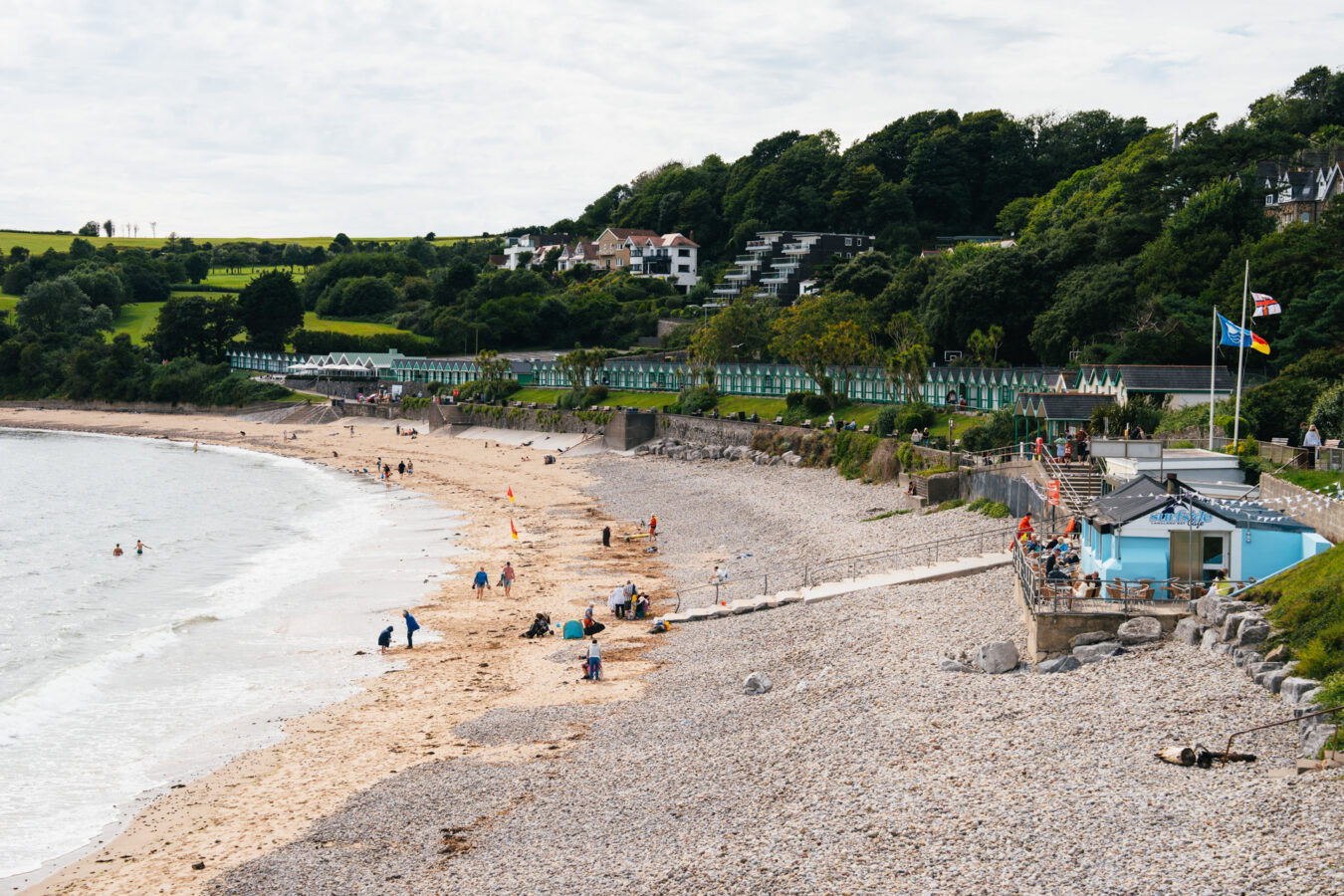
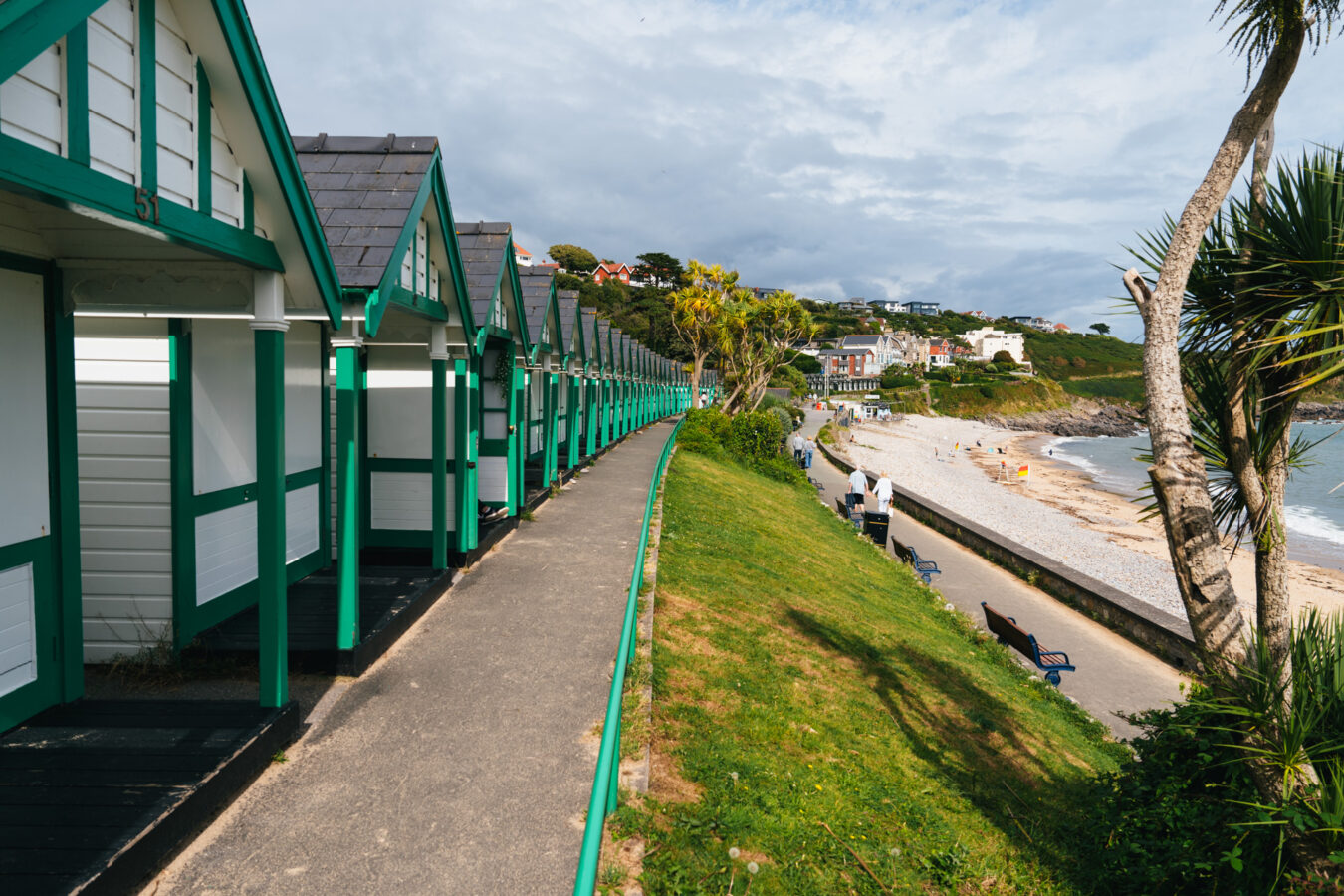
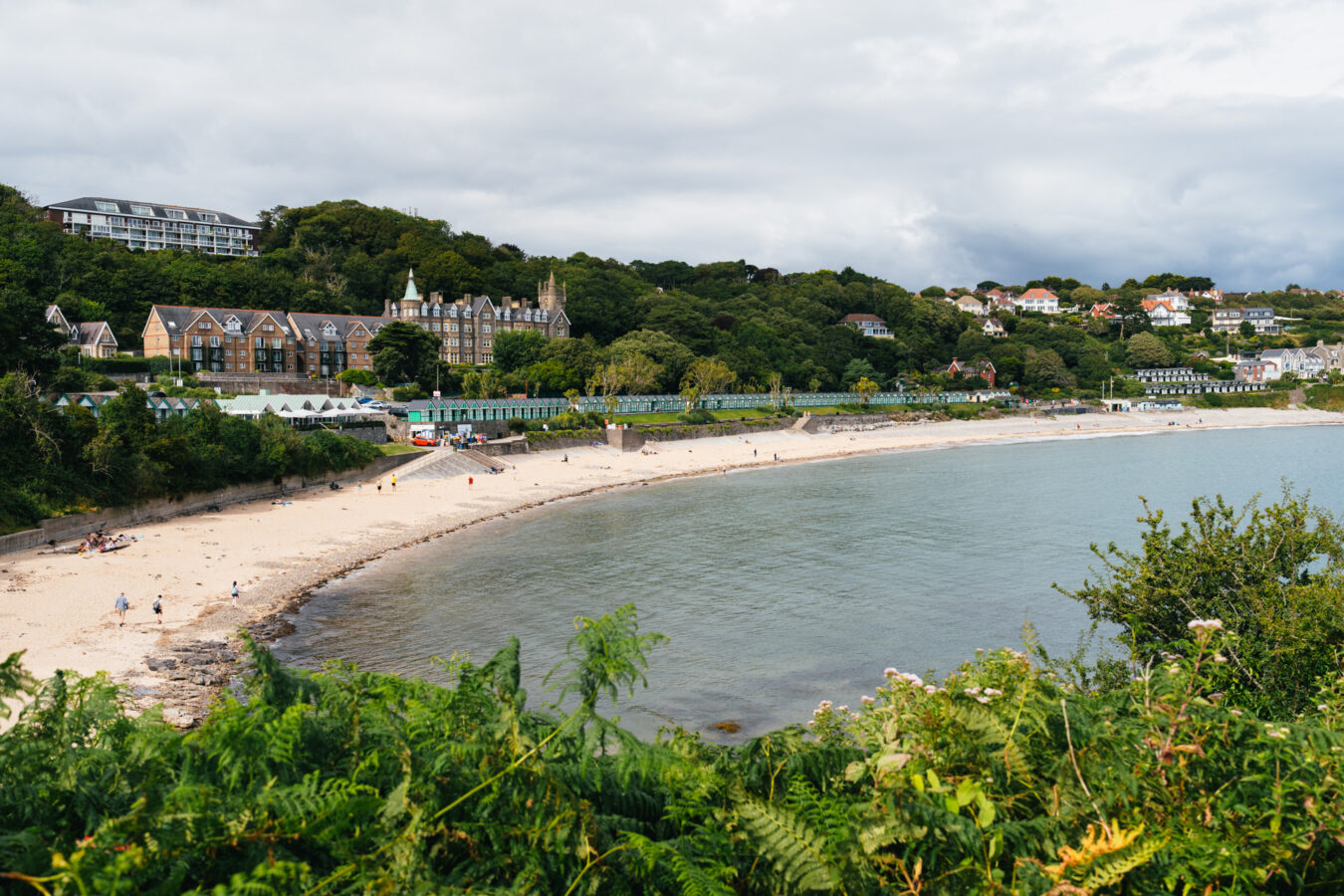
useful info about Bracelet bay and langland bay
See Bracelet Bay on
Google Maps | Apple Maps
See Langland Bay on
Google Maps | Apple Maps
Parking: Bracelet Bay and Langland Bay both have large Pay and Display car parks, so you can also drive there if you prefer.
EV charging stations: A few Clenergy slow chargers are available — two at the Bracelet Bay car park and two at the car park at the end of Langland Bay Road.
Public transport: Buses 2, 3A and 112 serve these areas. Note that there is no bus stop directly by the beach at Langland Bay, but it’s only a short downhill walk away.
Dogs: Not allowed on either beach from early May to the end of September.
Amenities: public toilets, restaurants and cafés
Accessibility: Only Langland Beach is accessible for wheelchair users. Accessible toilets are available at both bays.
Lifeguard: Only Langland is patrolled, during Easter half-term and daily from early May to mid-September.
Day 3 – Rhossili, Sunflower Field and Three Cliffs Bay
When searching for information on the Gower, Rhossili is always the spot that comes up first. Its iconic views — tall cliffs overlooking an immense stretch of golden sand — are impossible not to recognise, especially with wild horses wandering nearby. Situated on the western part of the peninsula, Rhossili Bay was therefore our main stop on the third day of our trip.
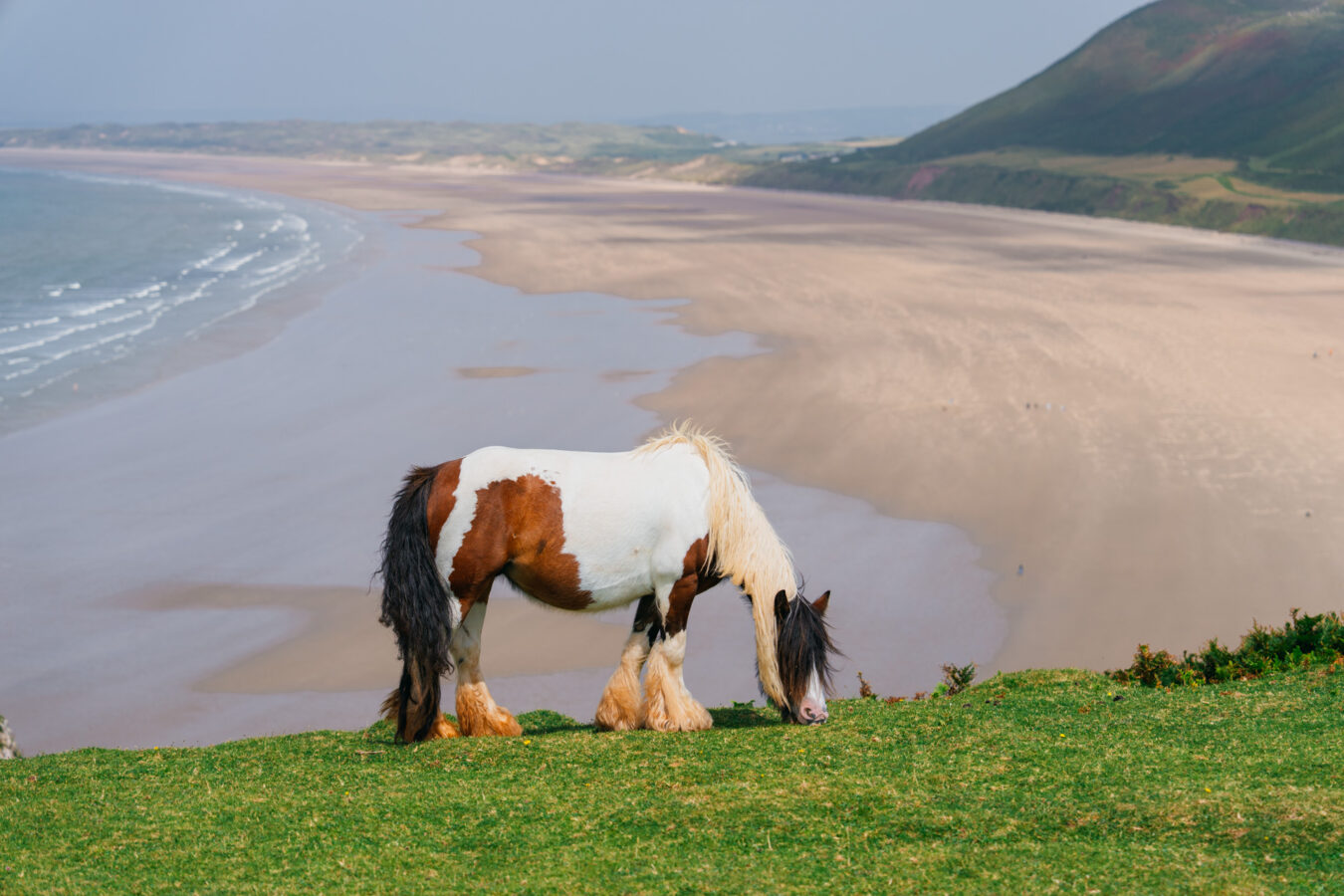
After a 40-minute drive, we arrived at the National Trust car park, which sits right next to the iconic Worm’s Head Hotel. Sadly, the hotel had recently suffered heavy damage in a devastating fire. A fundraiser is under way to help this family-run business get back on its feet, so please consider supporting them.
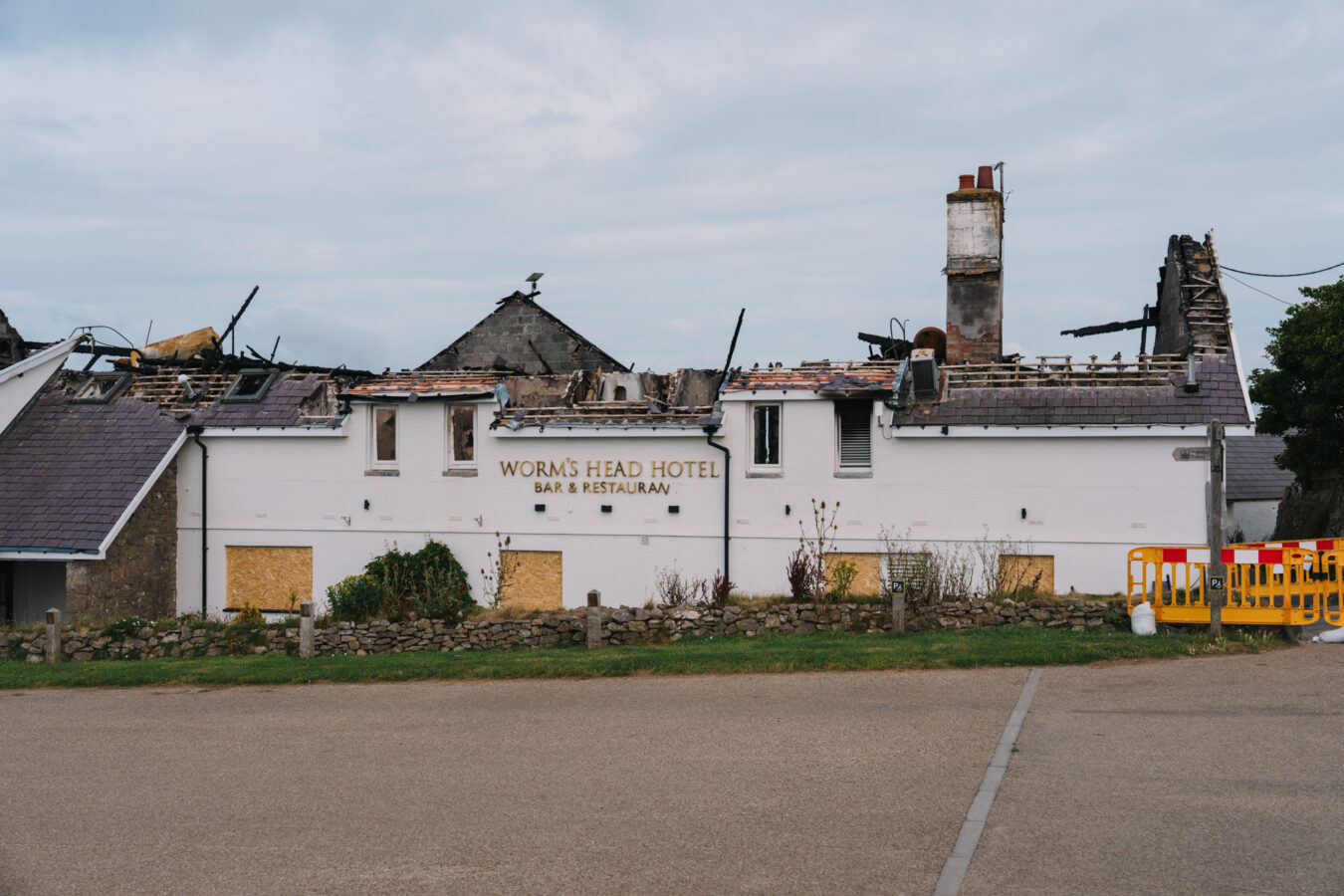
We decided to head first to the sunflower field, an iconic sight just a few minutes’ walk away. Along the path, you can admire dramatic views of the bay from the cliffs, passing tranquil wild horses that seem perfectly at ease around people — provided you don’t disturb them, of course.
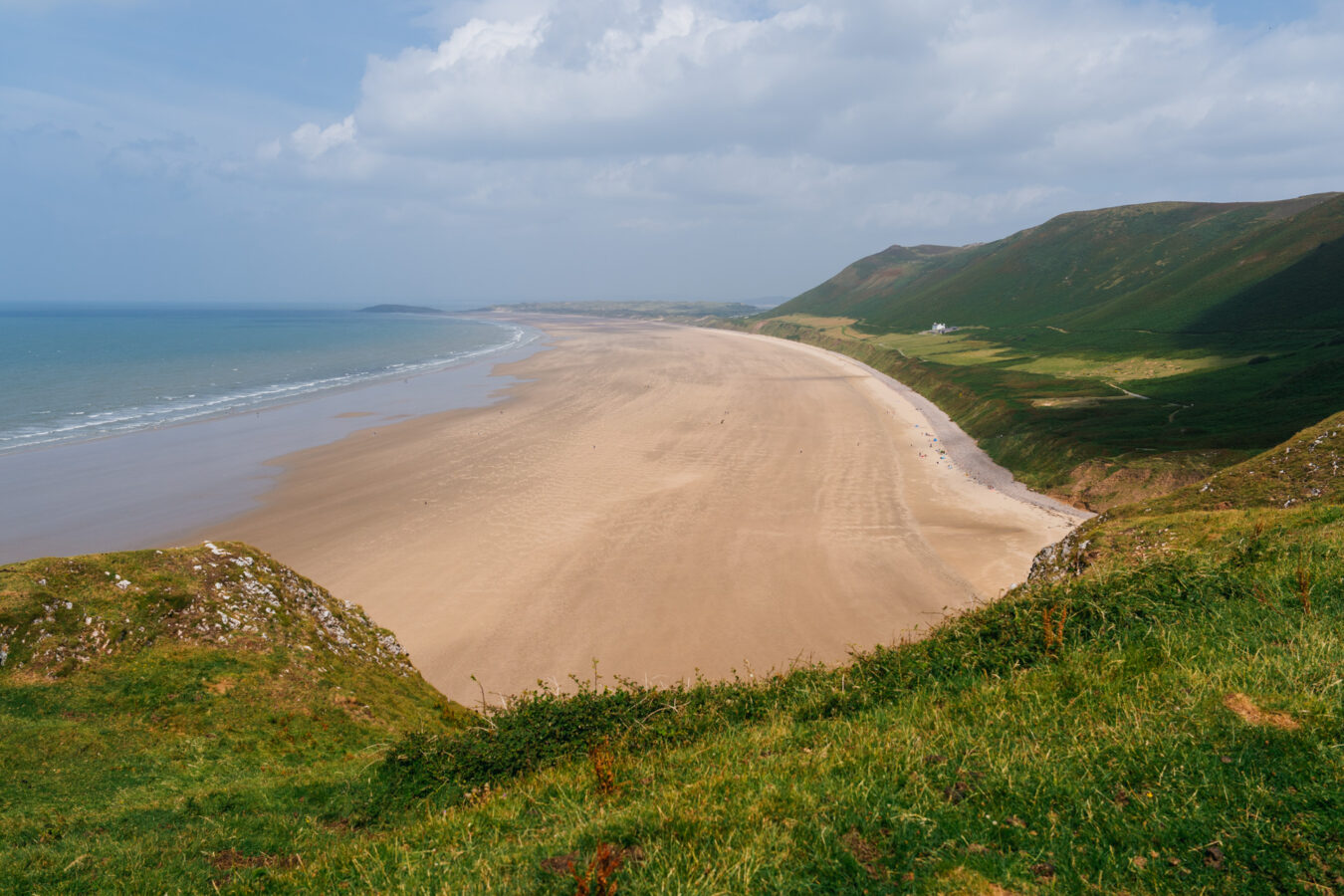
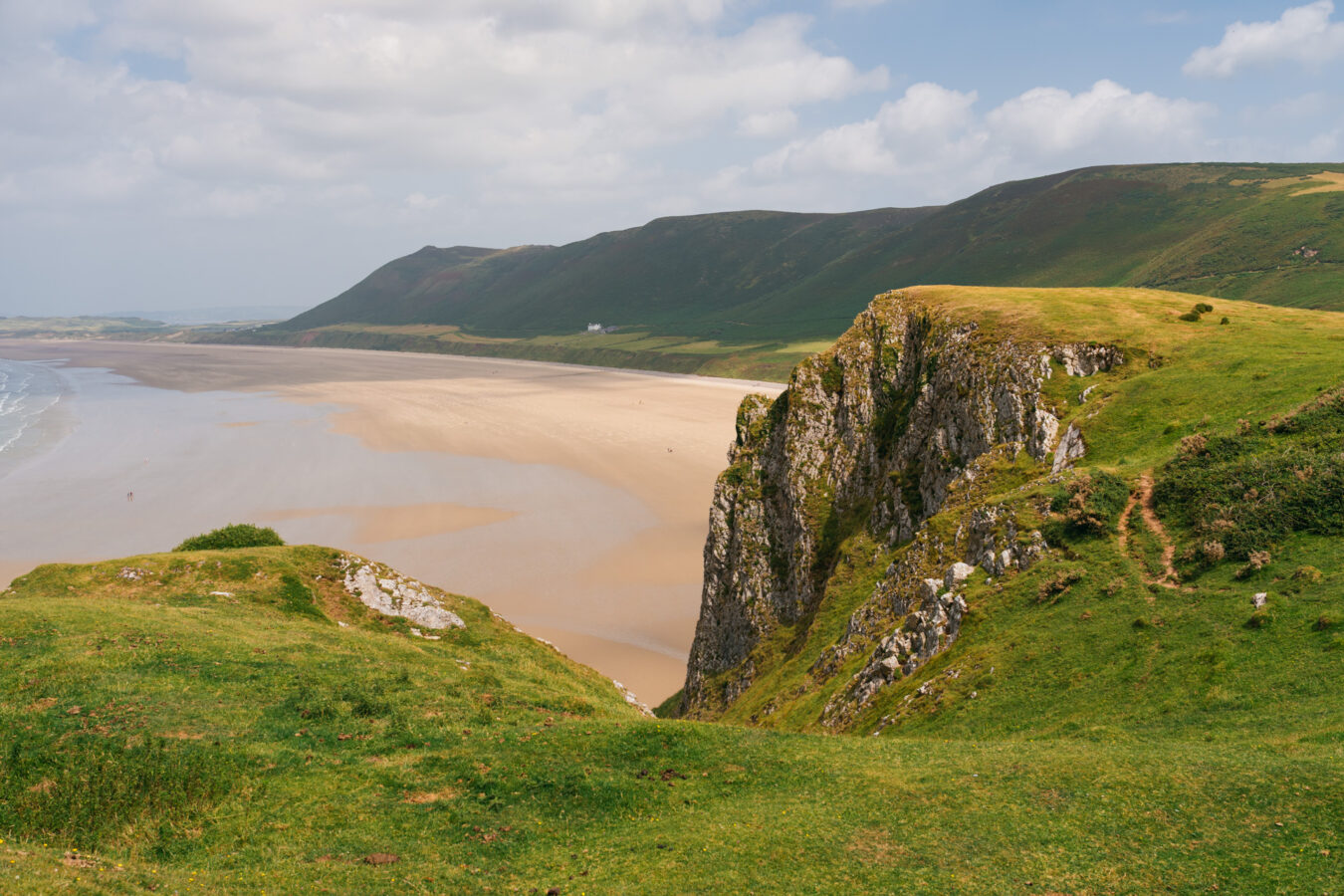
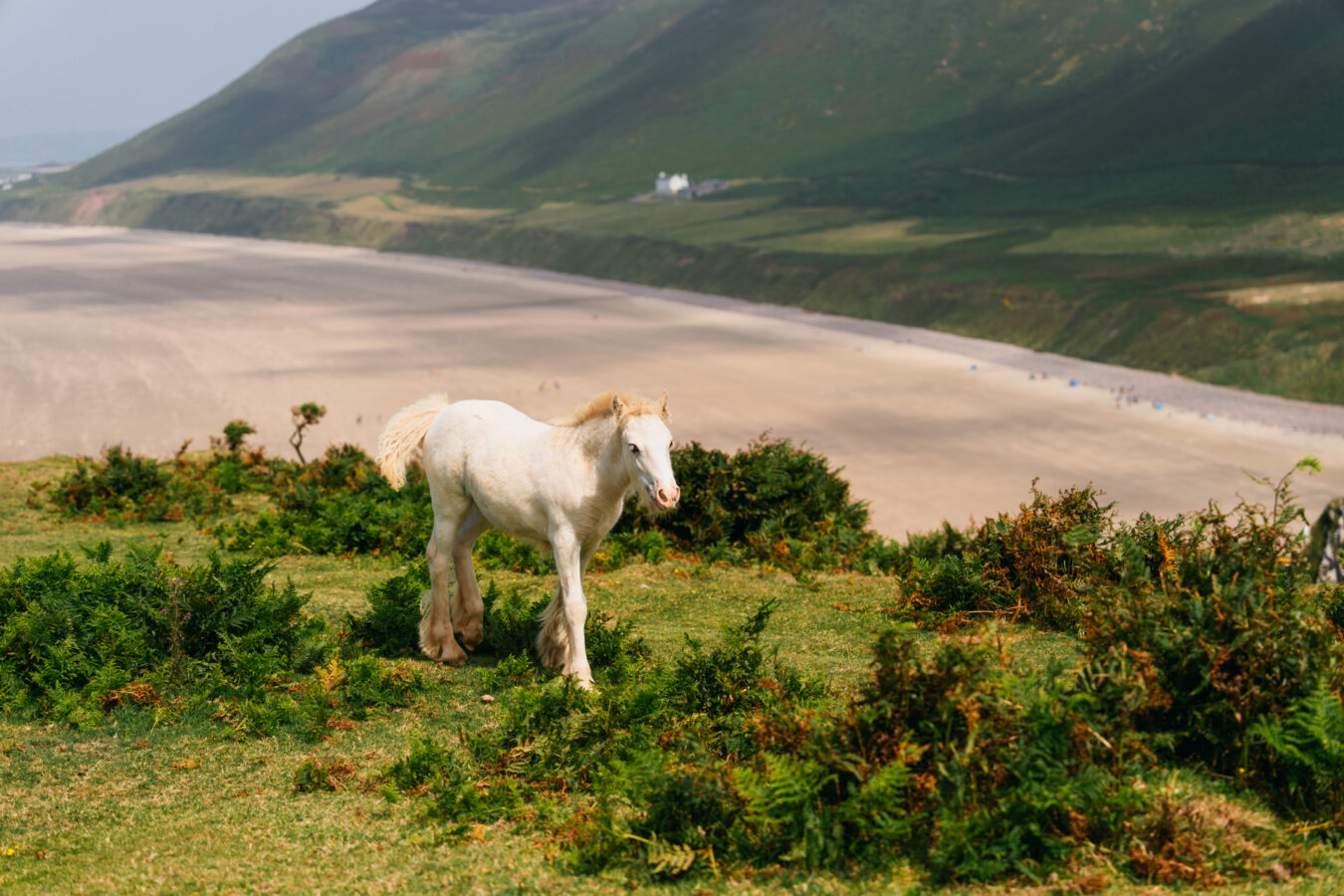

Rhossili Sunflowers covers around eight acres and turns golden from mid-July for four to five weeks. If you want to see it, you’ll need to time your visit between the second half of July and the first half of August. The organisers post regular updates on Facebook, so it’s worth following them.
The field was once famous for its vegetables (some of the best in Britain), but when demand declined, local farmers came up with the idea of repurposing it to attract visitors. Today, you can pick your own sunflowers to take home or buy seeds. The field is full of photo opportunities and even features a treasure hunt for children.
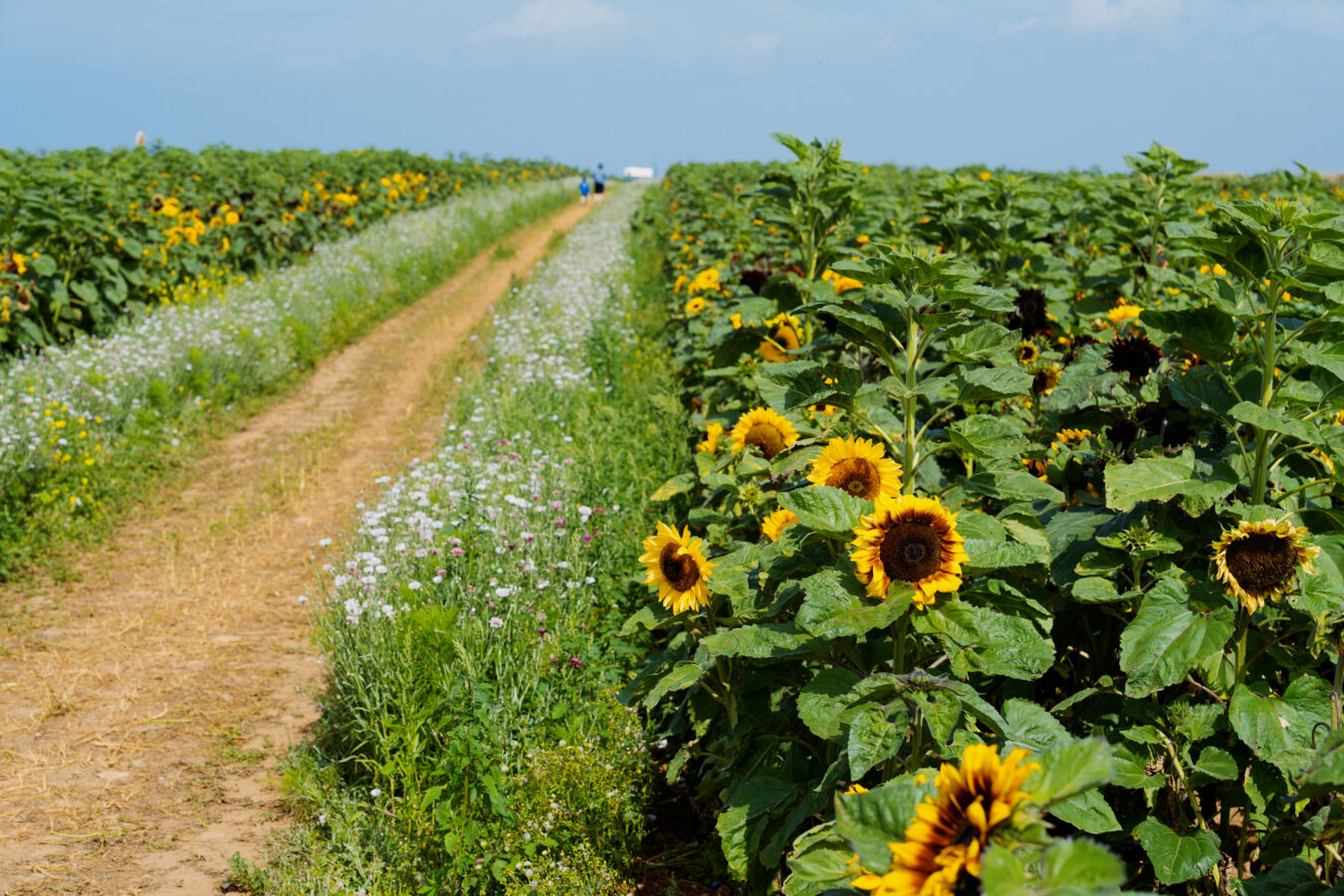
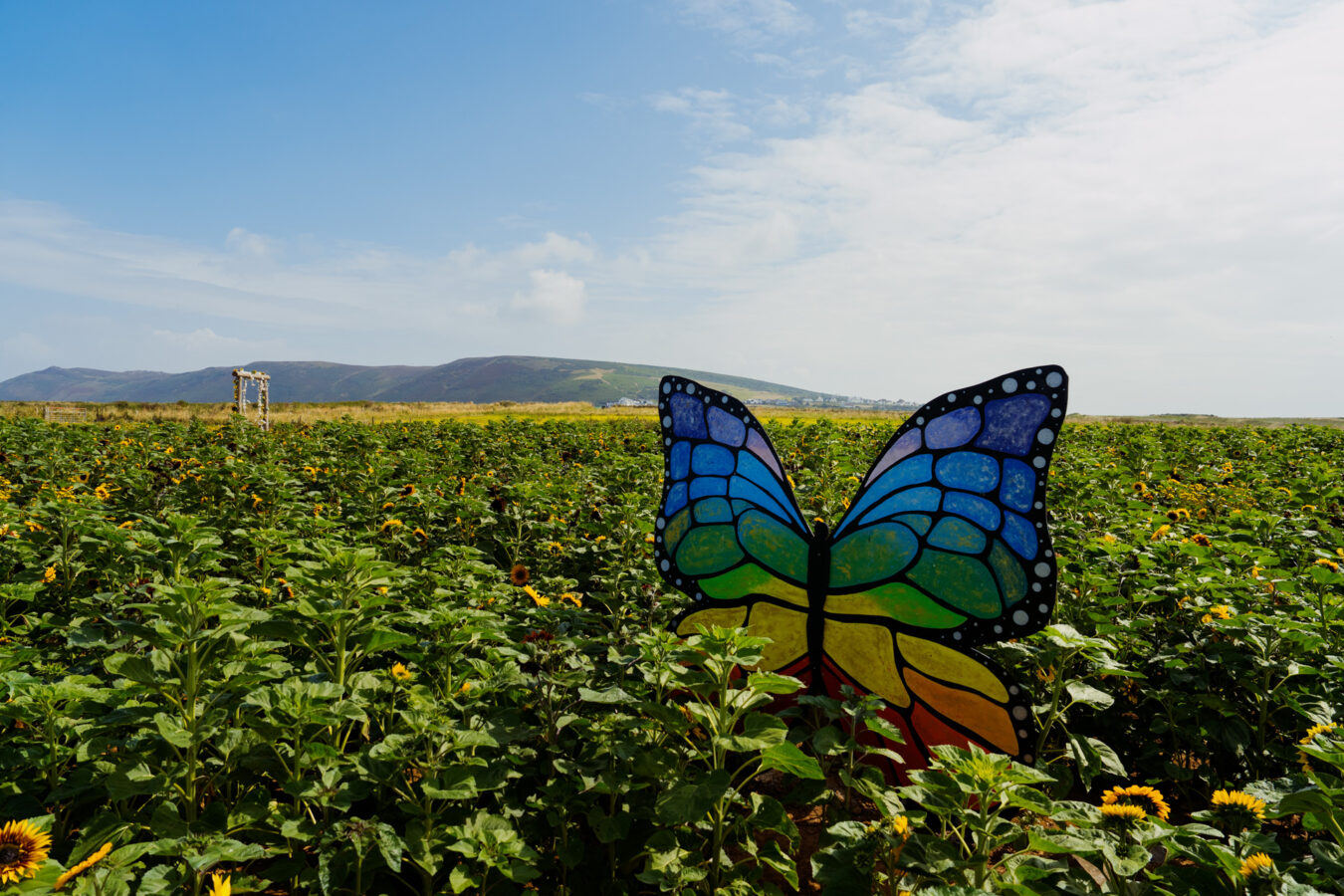
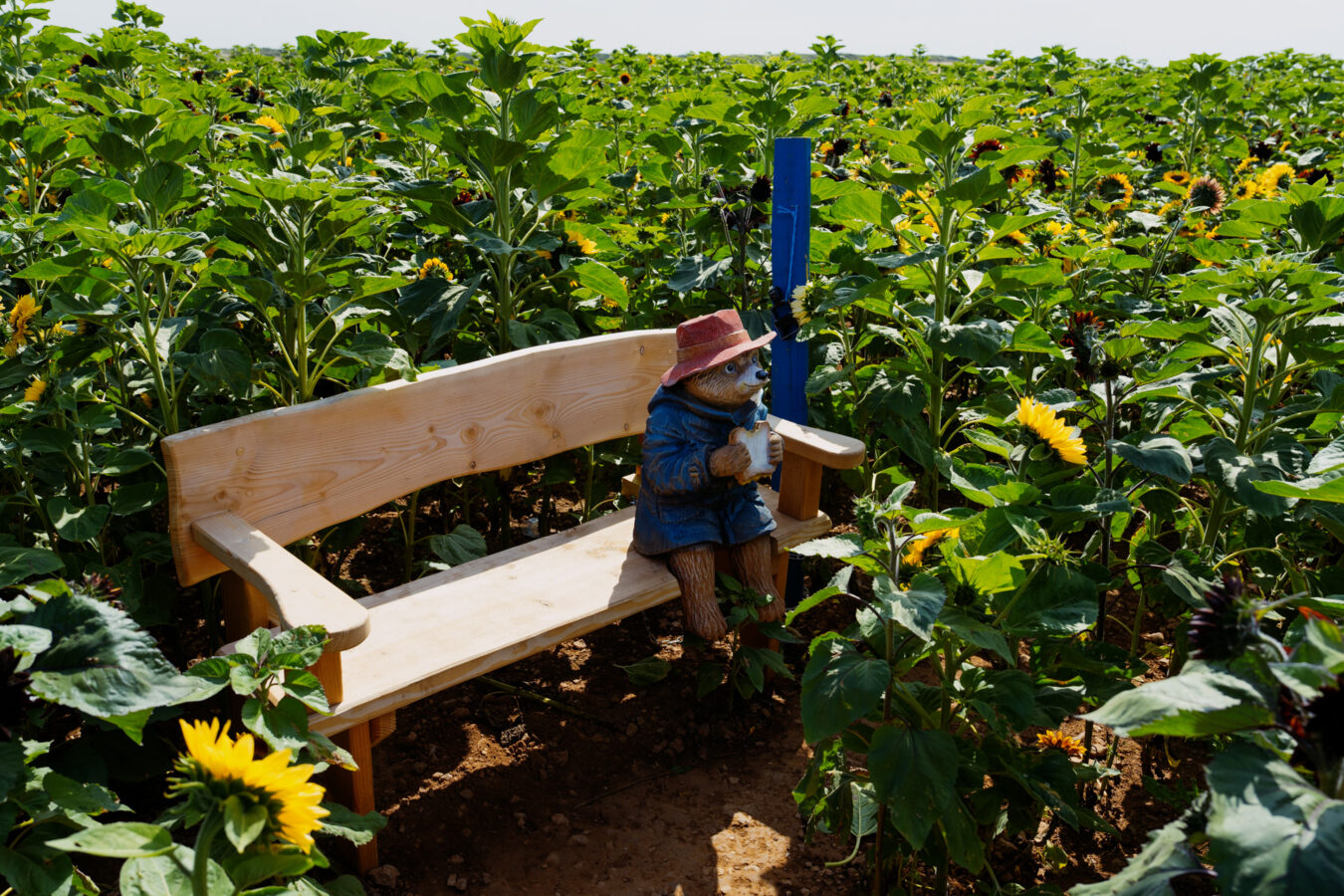

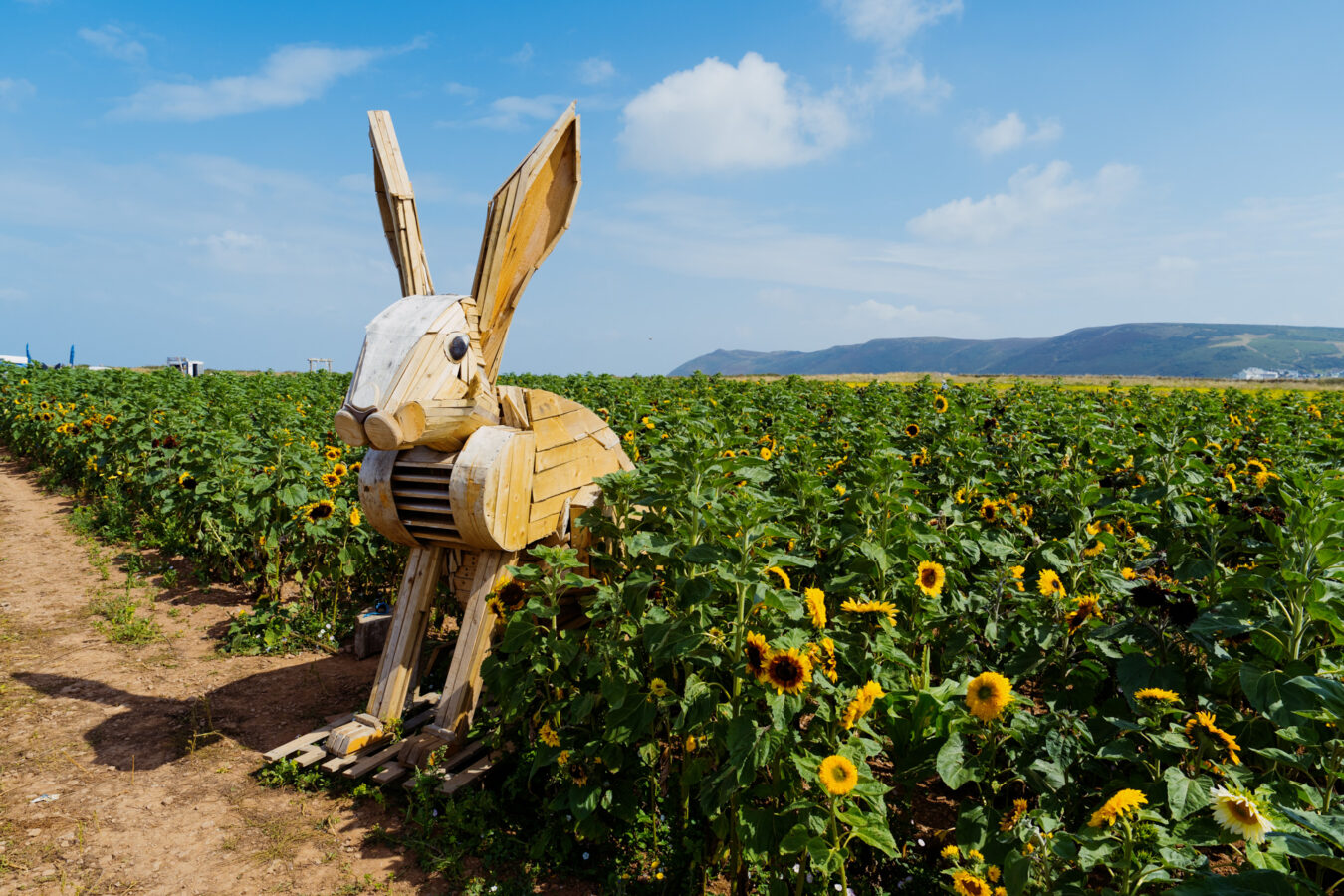

After the sunflower field, we made our way to Rhossili Point, where you can see Worm’s Head, the furthest westerly point of the Gower Peninsula. This mile-long headland consists of three islands: the Inner Head, the Middle Head and the Outer Head. The Middle Head contains a collapsed sea cave known as the Devil’s Bridge.
Worm’s Head can only be accessed at low tide, and a sign is updated daily with the approximate crossing times (the walk takes around four hours there and back). I couldn’t go sadly, as we arrived too late — next time!
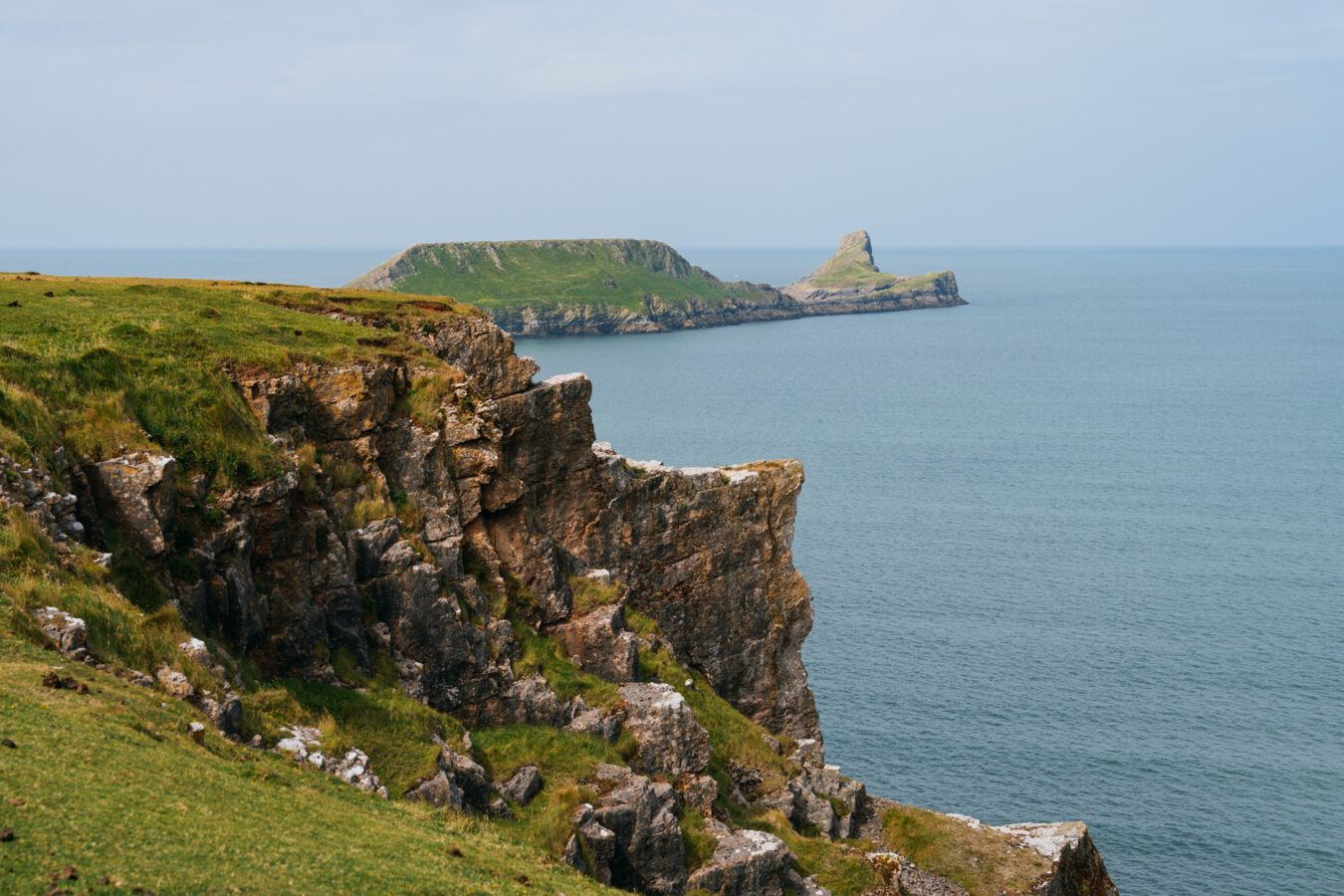
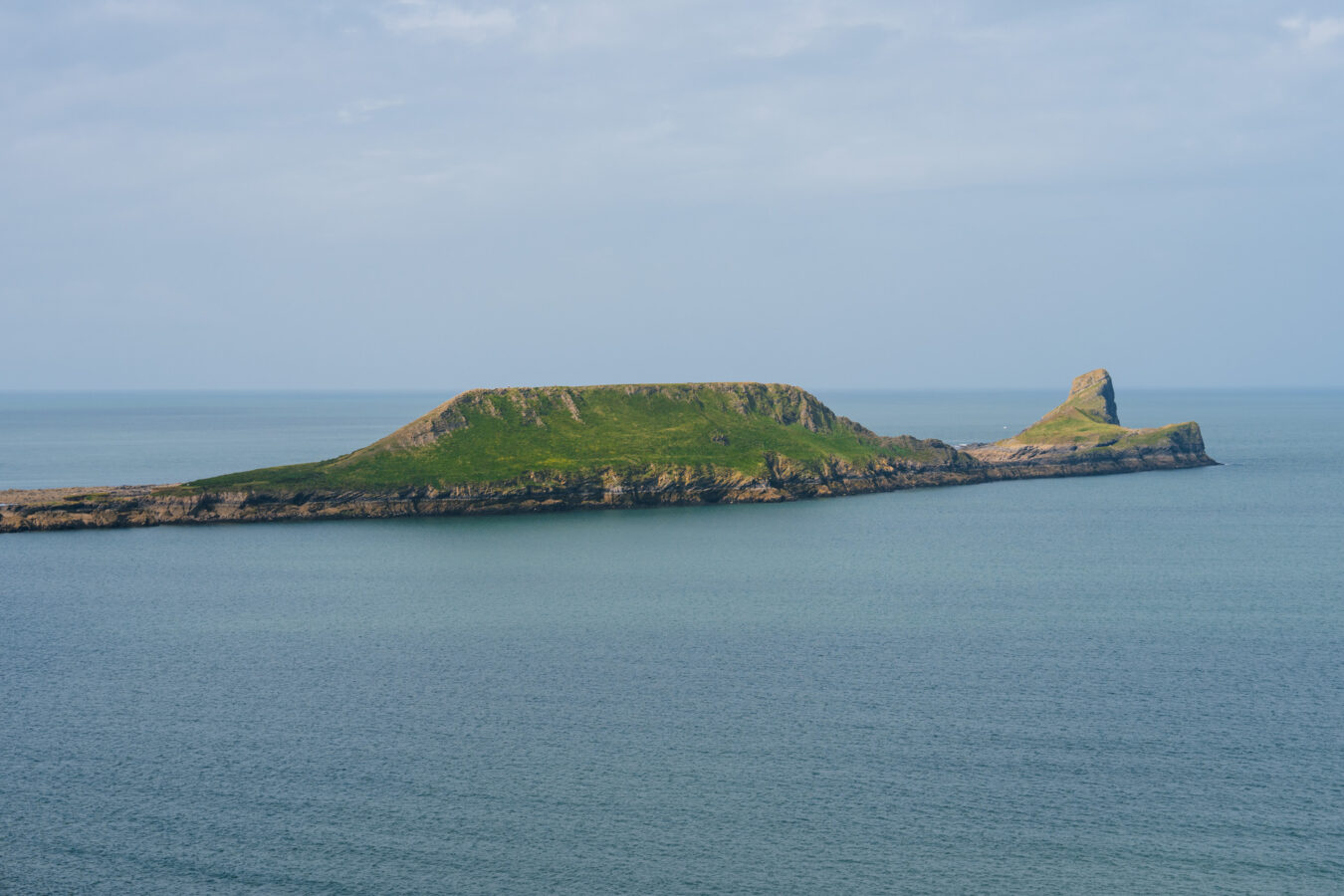
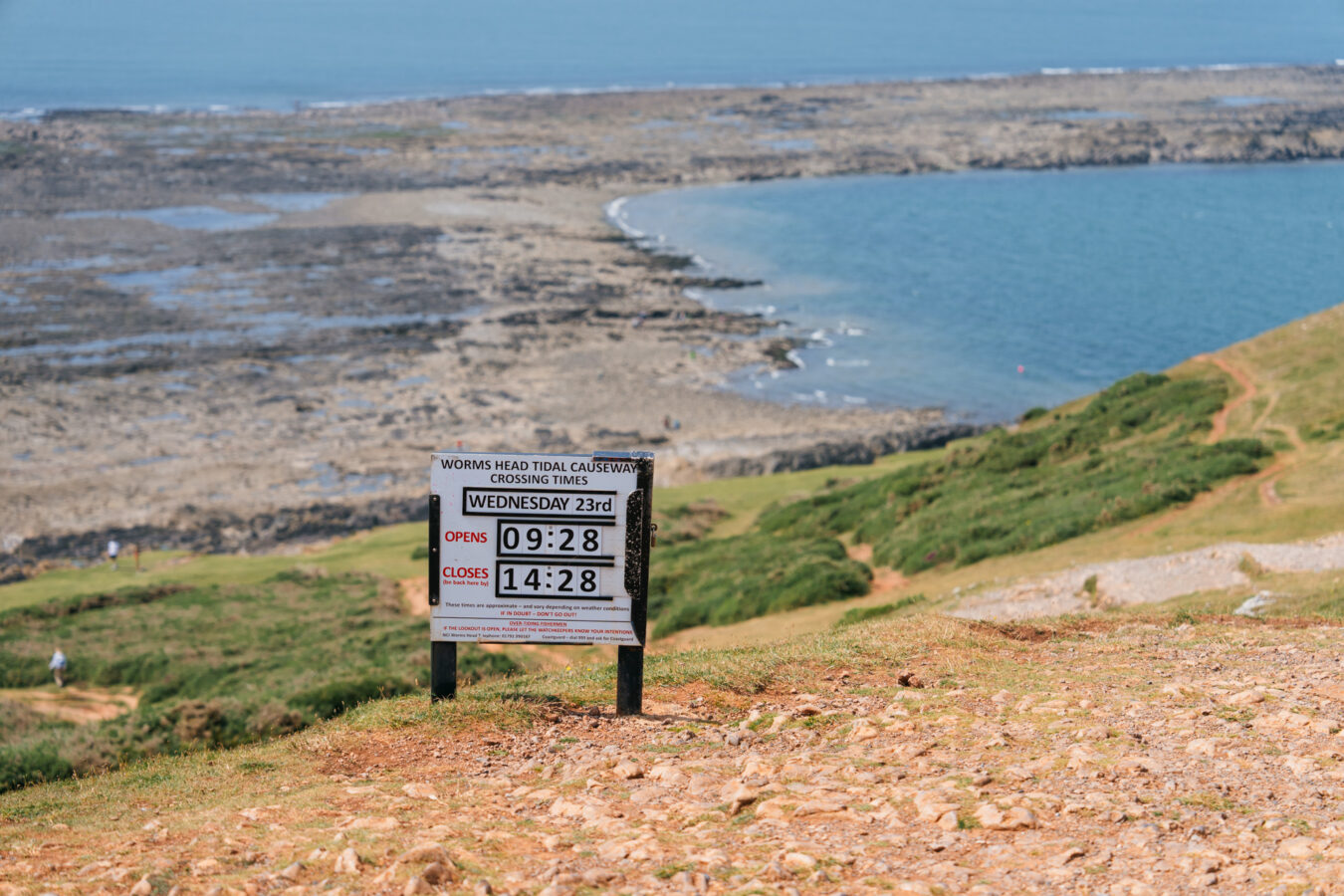
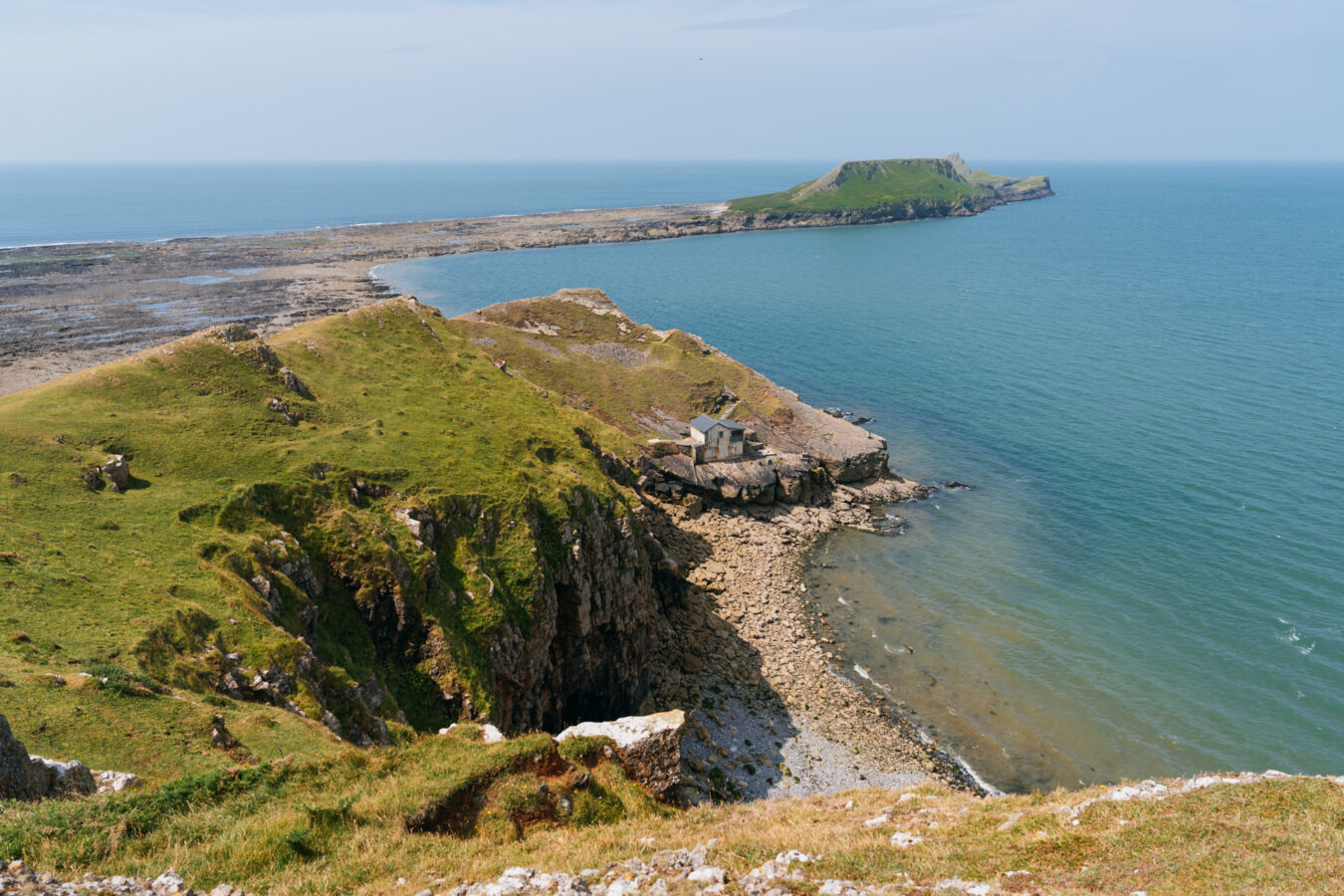
For lunch, we stopped at The View, which, as the name suggests, greets customers with a stunning panorama of the bay and beach. The food was excellent too — tasty salads and a superb burger topped with rarebit. Highly recommended!
useful info about rhossili
See Rhossili on
Google Maps | Apple Maps
Parking: Leaving your car is straightforward thanks to the large National Trust car park. Fees are £4 for two hours or £8 for the day (£5 and £10 for campervans). Parking is free for NT members.
Public transport: Buses 118 and 119 stop at the NT car park.
Dogs: Allowed on the beach all year round.
Accessibility: The gravel footpath along the cliff is easy to access; however, the route down to the beach is via a steep path with some steps. Accessible toilets are available at the car park.
Amenities: public toilets, two restaurants, NT shop
Rhossili Sunflowers Field: Open from mid-July to mid-August, although the exact dates vary. Entry is £4. A food truck is available on site, but there are no toilets. See the website for more information.
Lifeguards: There are no lifeguards on Rhossili Beach.
In the afternoon, we decided to get back in the car and explore another area, but it’s worth noting that you can easily spend a full day in Rhossili, as there are plenty of walks both along the coast and up into the hills (I mention them further down on Day 5).
We drove to another highlight of the Gower: Three Cliffs Bay. Unlike Rhossili, there are no car parks close to the beach, so you need to walk in. Depending on where you park, the walk can take between 20 and 45 minutes. Once you arrive, the view more than rewards the effort: a spectacular shoreline of sand dunes, salt marsh, and the three limestone cliffs that give the bay its name.

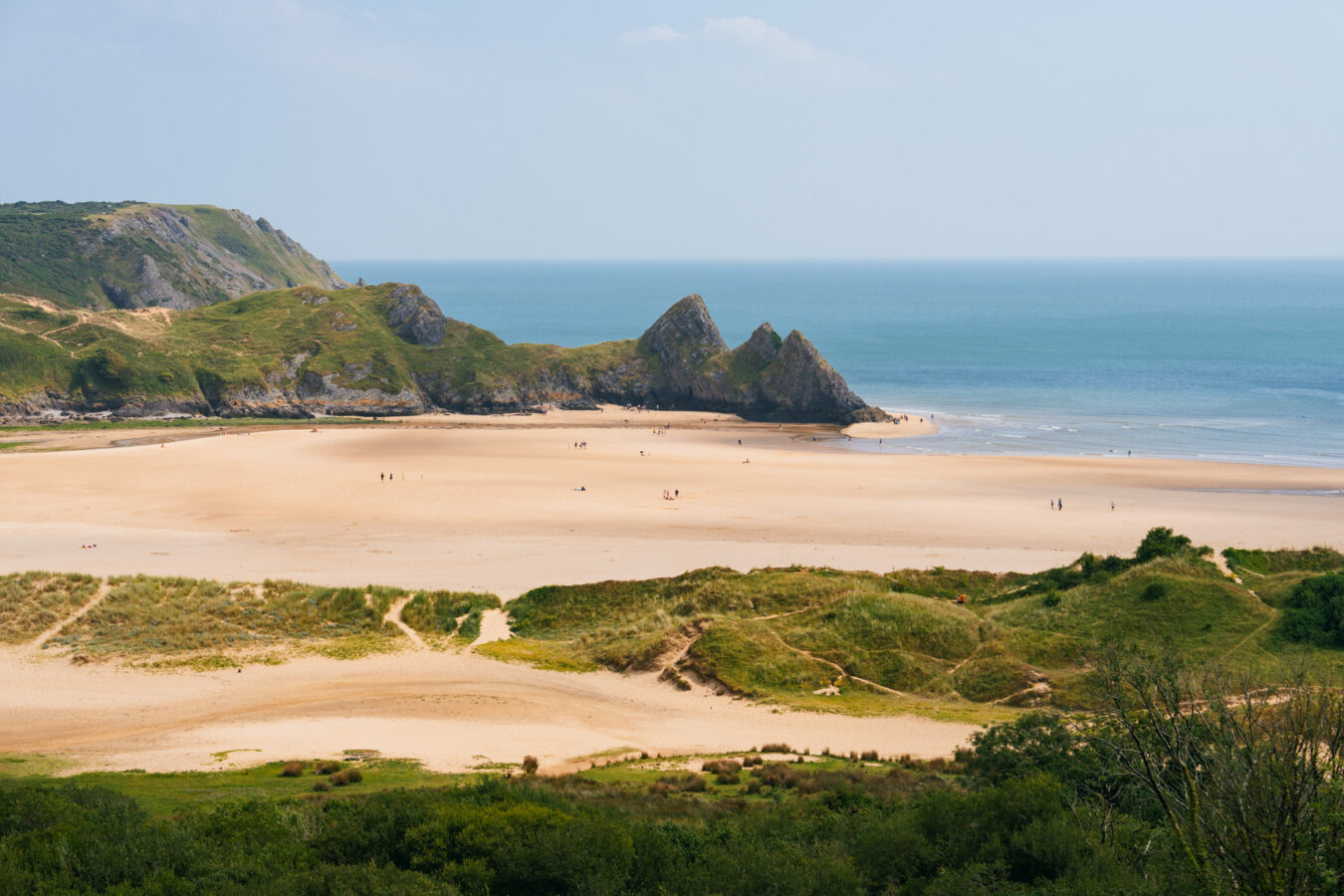
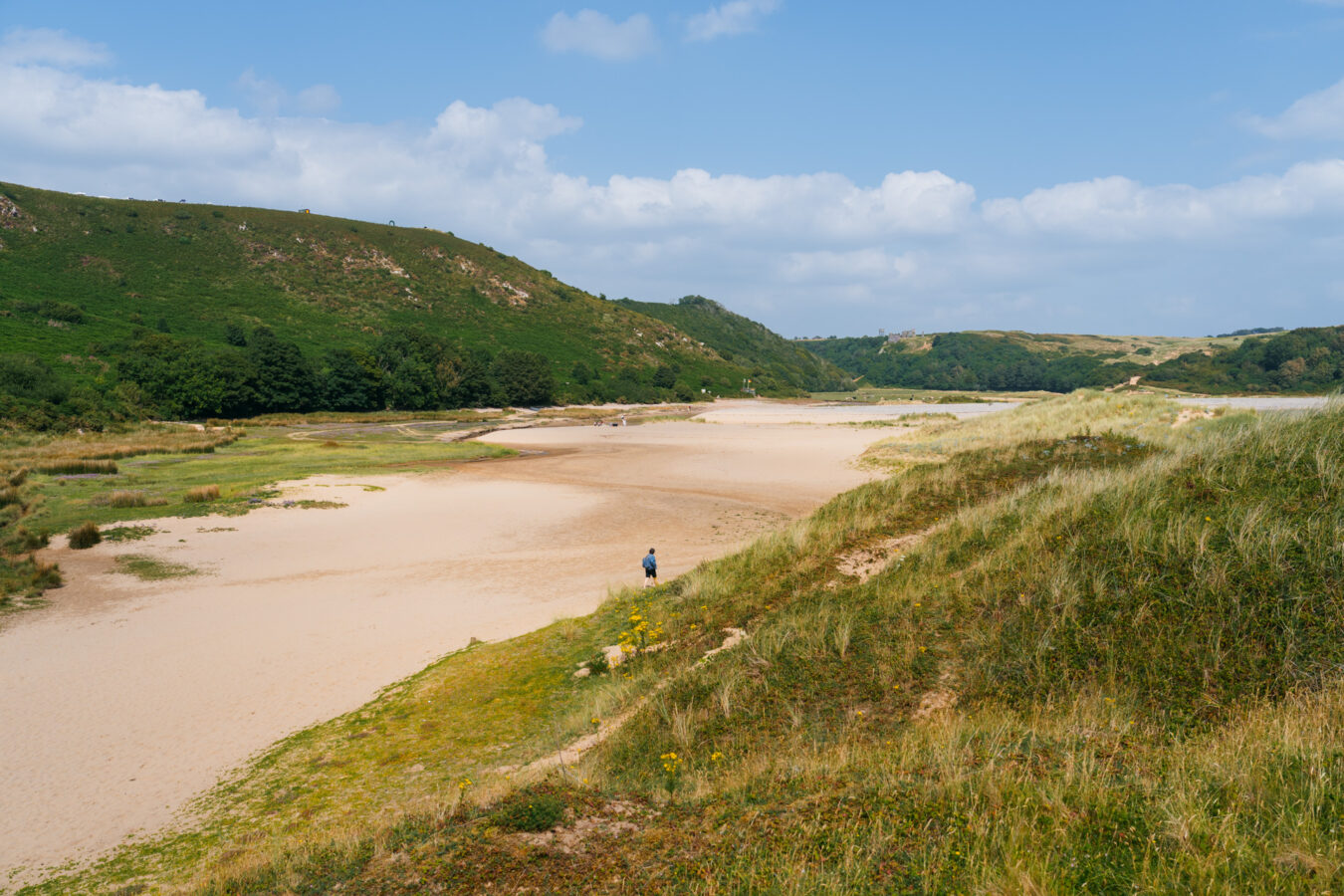
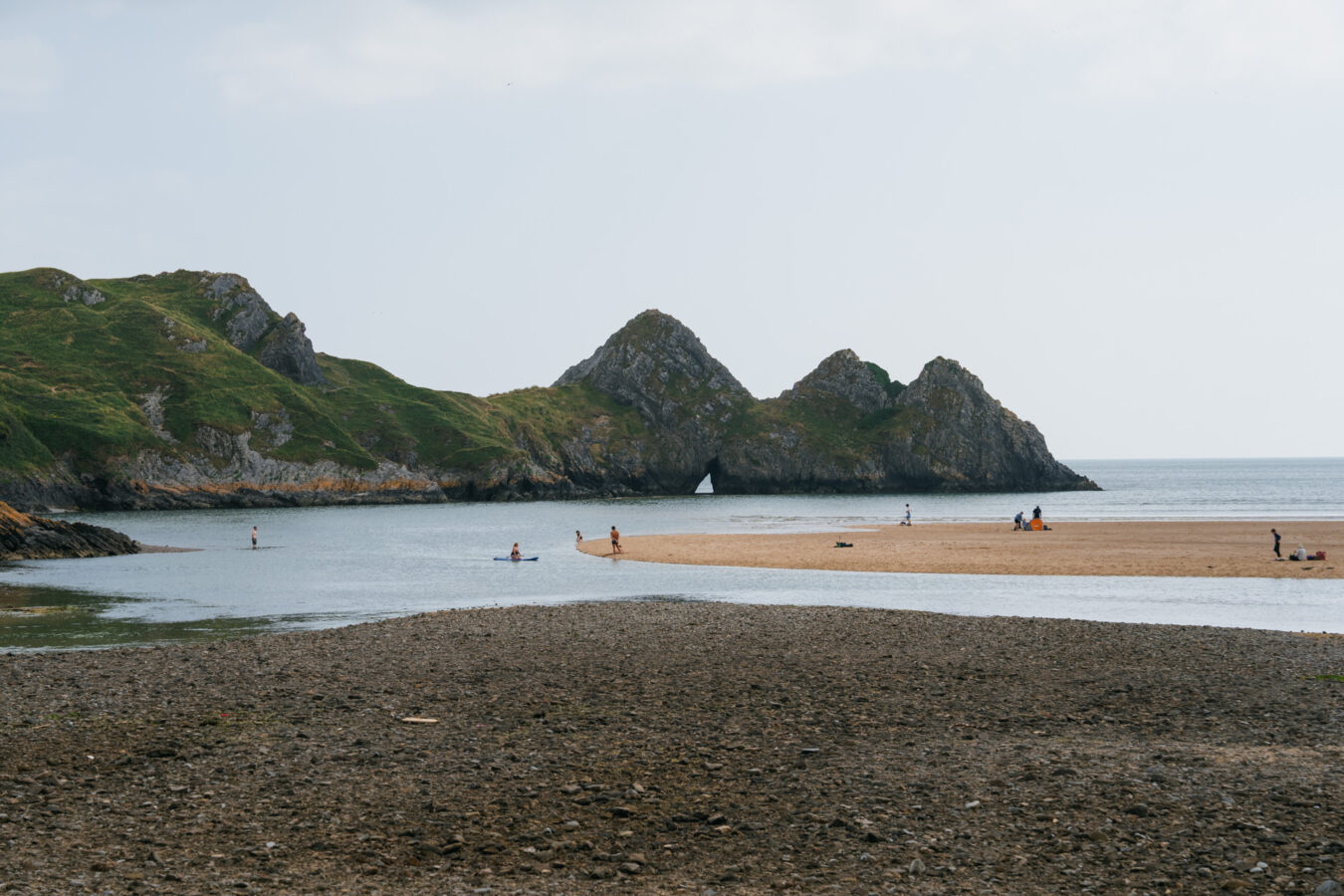
At low tide, the beach is vast, with plenty of rock pools to explore. Needless to say, my son immediately began building sandcastles! While the rest of the family relaxed on the beach, I hiked uphill for about 25 minutes to the ruins of Pennard Castle. Shrouded in legends and folklore, it also offers a fantastic viewpoint over the bay. It’s an ideal spot for photography, particularly at sunset.
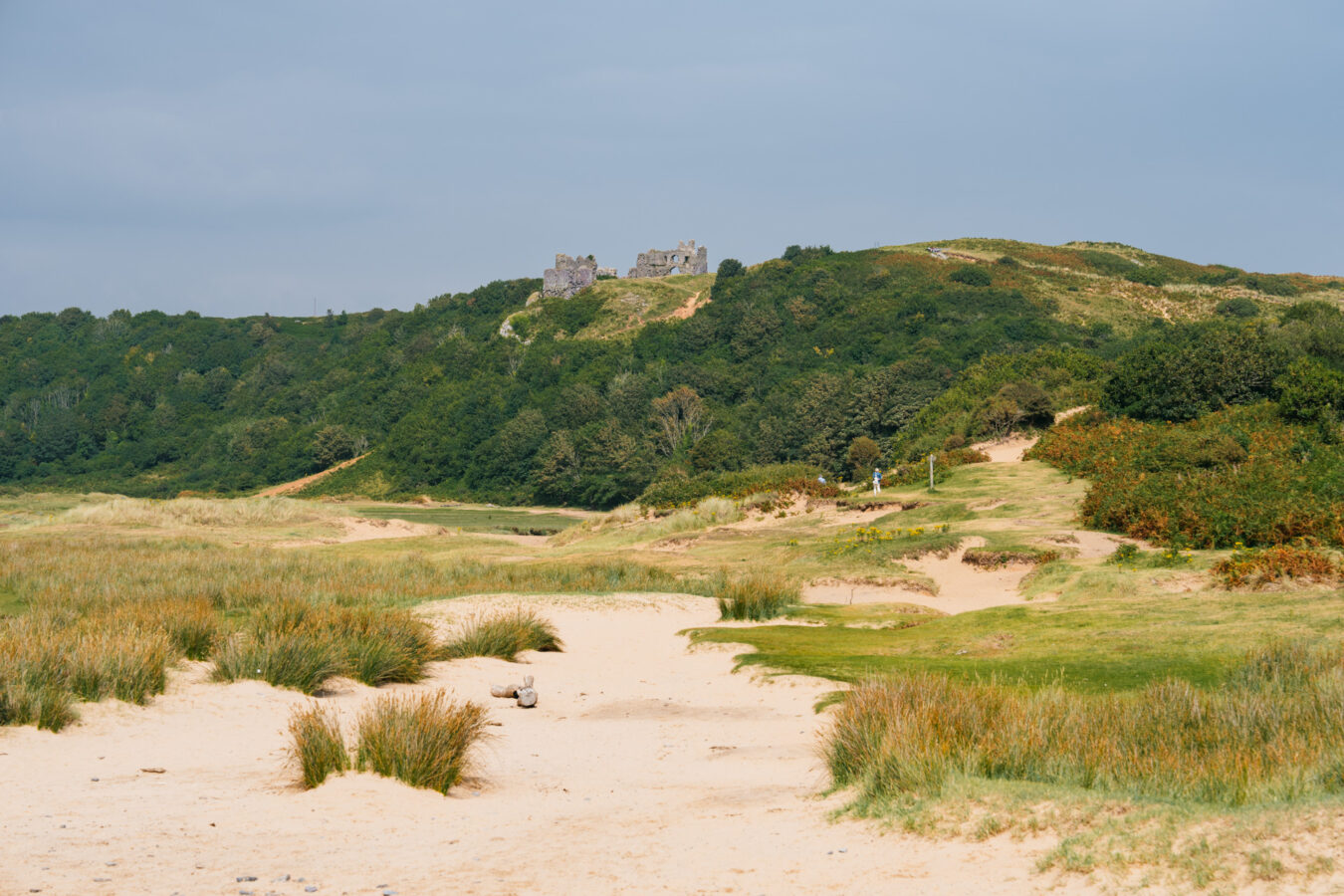
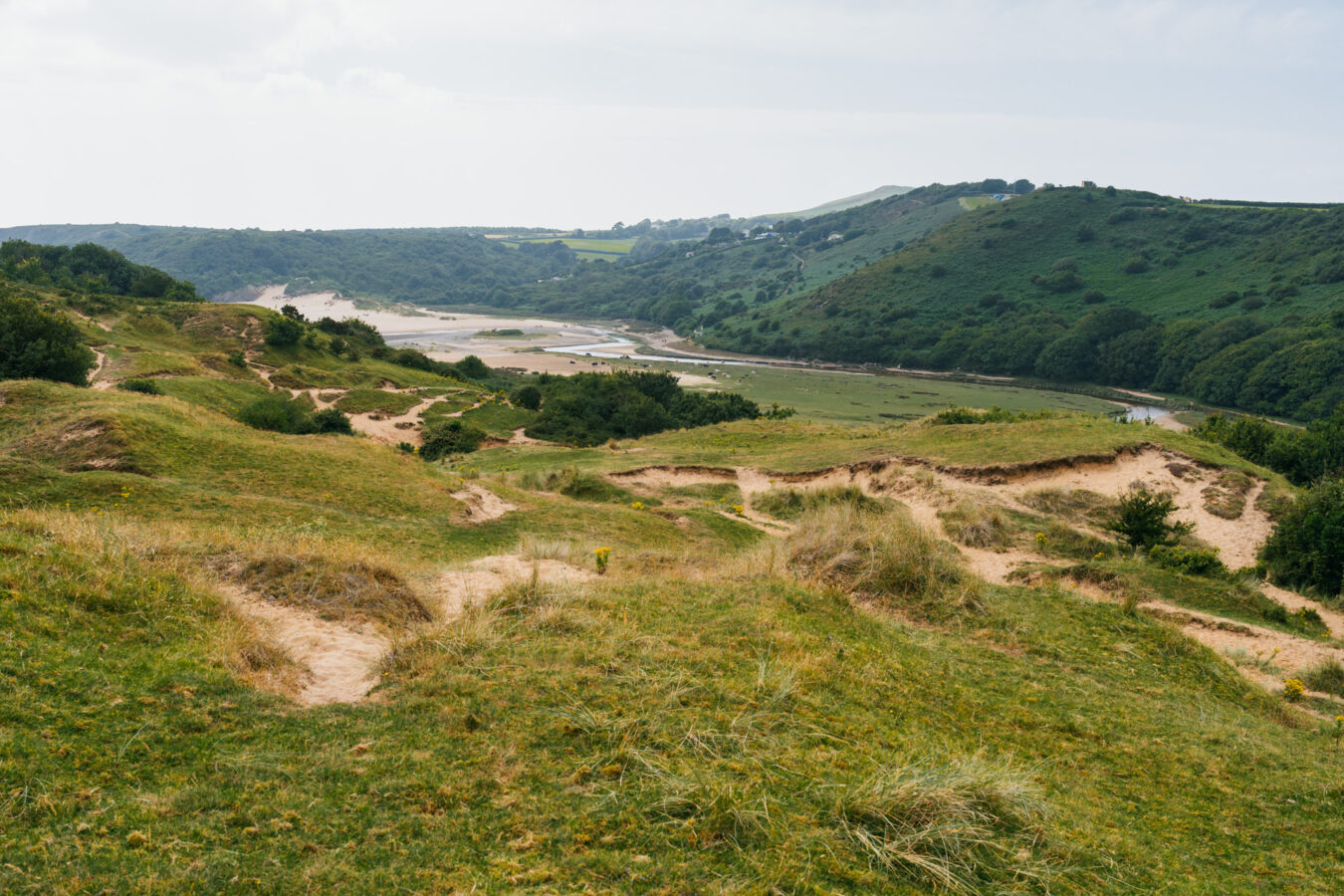
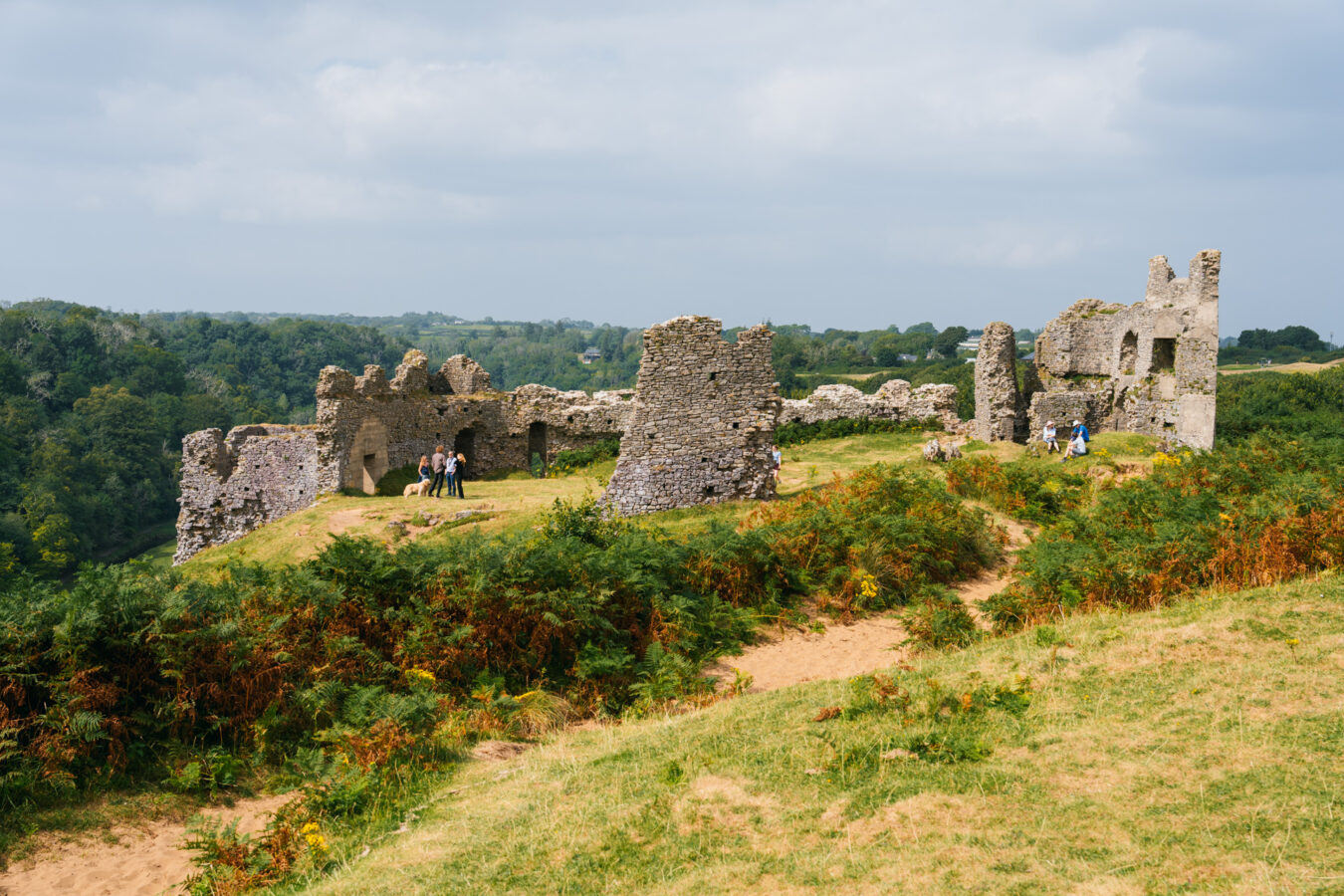
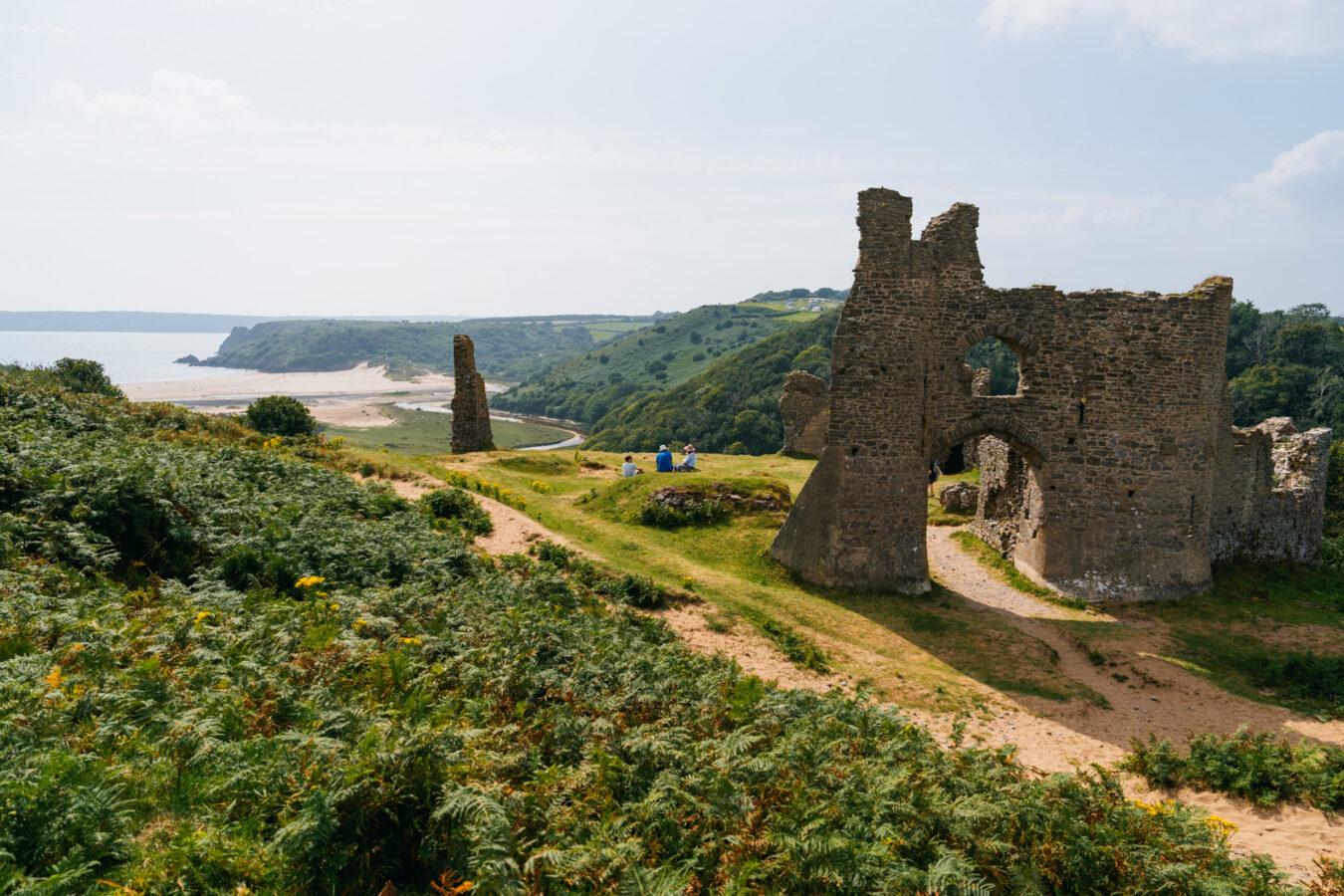
useful info about three cliffs bay
Parking: There are no car parks directly by the beach. You can leave your car in the nearby villages of Penmaen, Southgate or Parkmill, from where the walk takes between 15 and 30 minutes depending on where you start. We parked in Penmaen, as it provides the shortest route to the beach. See map and links below.
See Three Cliffs Bay parking options on Google Maps:
Penmaen | Parkmill | Southgate
See walking route options to Three Cliffs Bay on Footpath:
From Penmaen | From Parkmill | From Southgate
Tides: Bear in mind that the Pennard Pill river flows down through the valley into the sea, cutting the bay in two. A series of concrete stepping stones near the RNLI hut allows you to cross the river, but these become submerged at high tide. Always double-check tide times and plan where to park accordingly to avoid being cut off. Otherwise, your only option is to walk about half a mile upstream to the footbridge near Parkmill.
EV charging stations: The closest station is at the Gower Heritage Centre near Parkmill, and it is the fastest charger you’ll find on the whole peninsula (120kW). From the car park, it’s around a 30-minute walk to Three Cliffs Bay.
Public transport: Bus 14 and 112 stop at Southgate; buses 112, 117 and 118 serve Penmaen and Parkmill.
Dogs: Allowed on the beach all year round.
Amenities: no refreshment on the beach. Closest toilet is at the Three Cliffs Bay Holiday Park, near Penmaen (a 20-minute walk from the beach).
Accessibility: unfortunately due to the rough and steep nature of the footpath, the beach is not accessible for people with mobility issues.
Lifeguard: the beach is patrolled from mid July to early September.
Day 4 – Caswell Bay and Whiteford
We started the day with a stop at Caswell Bay for a nice cup of coffee at the Surfside Café. Caswell is another charming cove, with a large stretch of sand at low tide, and a popular spot for surfers. As we savoured our hot drinks, the first wave of children and their teachers were already gearing up — there are two surfing schools on site. The beach has Blue Flag status and is enjoyed by surfers and families alike. There is a car park directly opposite Caswell Road, with public toilets, and a few small shacks selling food and refreshments.
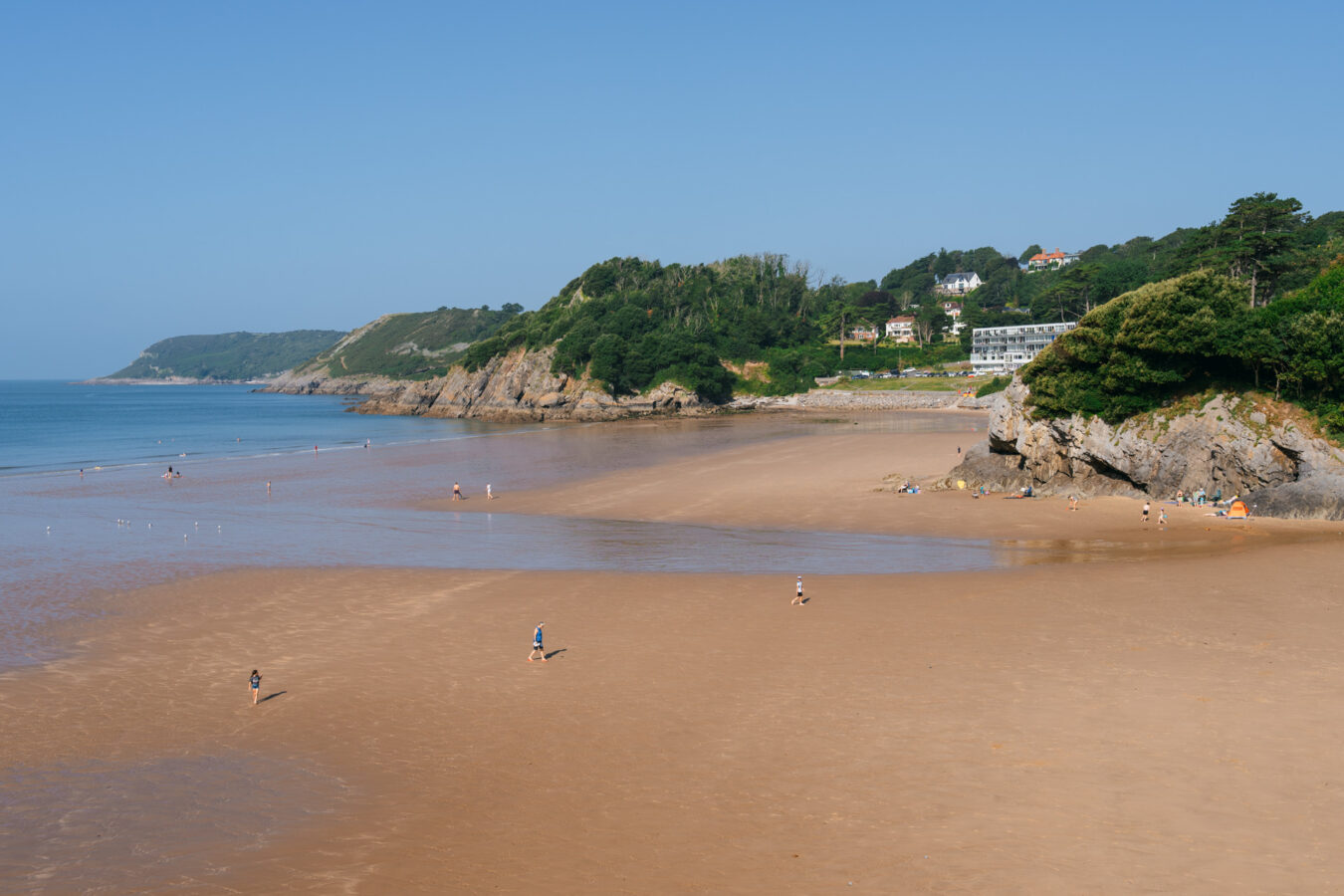
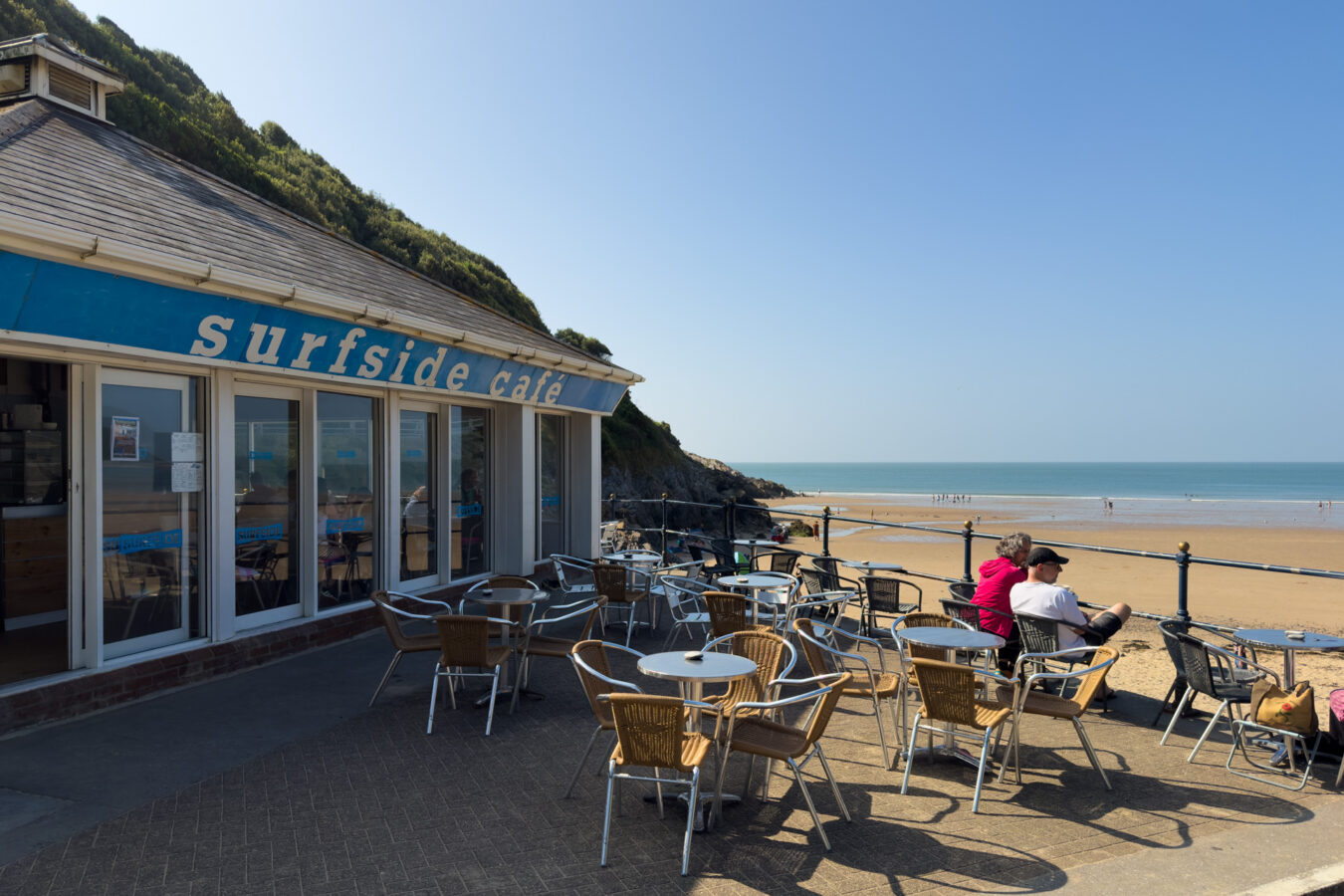
useful info about caswell bay
See Caswell Bay on
Google Maps | Apple Maps
Parking: The Whiteford Beach car park is located between Llanmadoc and the hamlet of Cwm-Ivy. When we visited, the ticket machine was out of order, but you can pay via the Your Parking Space app.
Public transport: Buses 115 and 116 stop at Llanmadoc, close to the beach car park.
Dogs: Not allowed on either beach from early May to the end of September.
Amenities: café, shop, public toilets
Accessibility: access on the beach for wheelchair users.
Lifeguard: no patrols on the beach.
Next, we tried to visit Castell Oxwich, which isn’t actually a castle but a Tudor manor house. Unfortunately, it was closed, with a sign indicating it only opens at select times on weekends.
We then headed to Port Eynon, another bay with a Blue Flag beach, some nearby camping sites, and a few fish and chip shops in the small village. The main reason I wanted to come here was to find the intriguing Culver Hole, a dovecote nestled somewhere on the cliff just west of the village. However, I quickly realised that the walk to get there wasn’t suitable with a five-year-old, and I didn’t want to keep the rest of the family waiting for what could have been a long excursion. I decided to postpone it and return on my own the next day. We stopped for refreshments before heading north.

After a 25-minute drive, we parked at Whiteford Beach car park, located between Llanmadoc and the hamlet of Cwm-Ivy (you aren’t allowed to drive further down the road). The area is striking and quite different from the south of the peninsula, with a mix of undulating fields and woodlands stretching down towards a nature reserve and salt marshes, before reaching the sand dunes of Whiteford Sands.
As we began to walk down to find the best route to the beach, the idyllic Cwm-Ivy Café offered breathtaking views that were too inviting to resist — and it was lunchtime anyway!
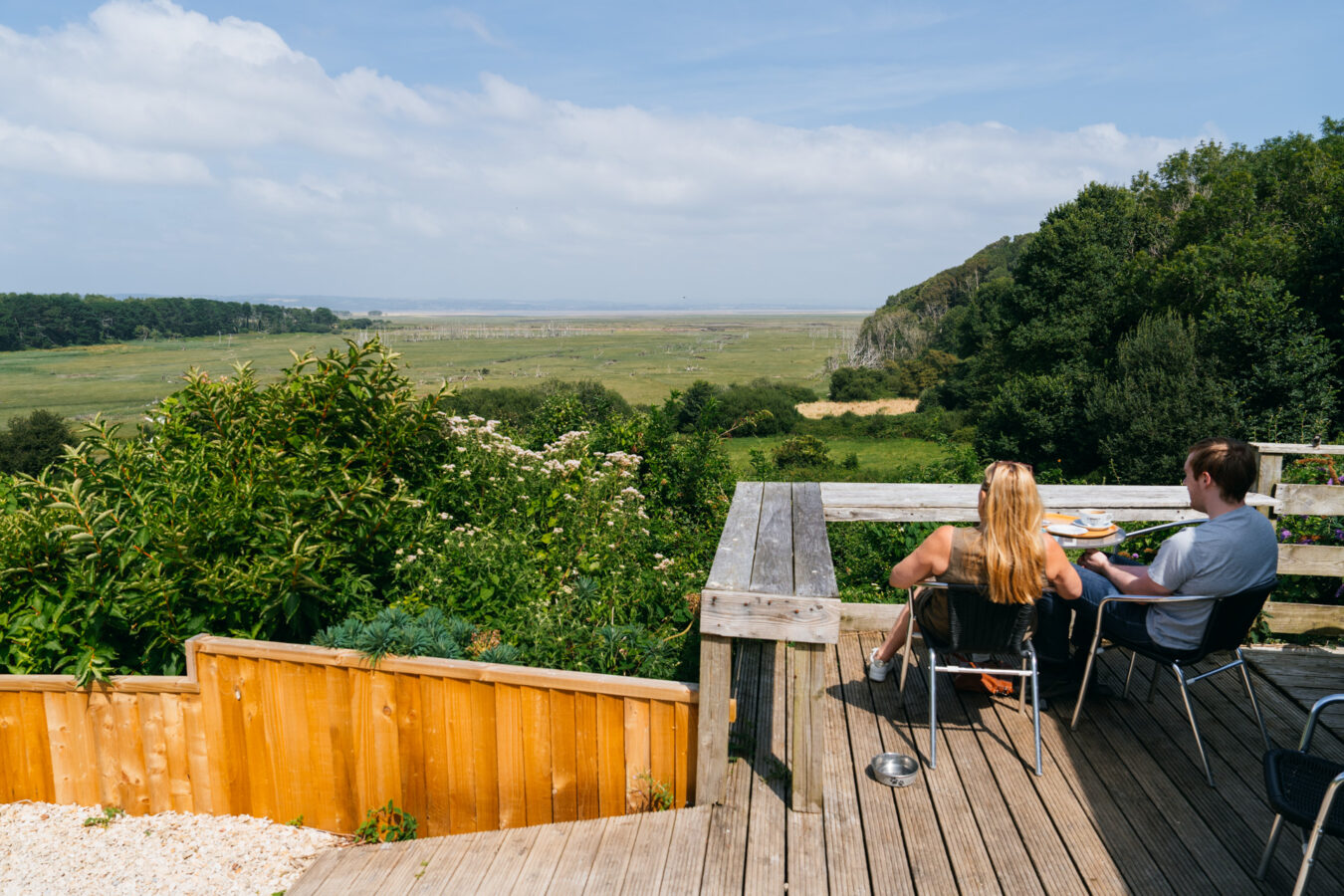
The path we chose started just outside the café. We walked through part of a beautiful woodland before reaching the sand dunes, where an impressive expanse of white sand stretches seemingly for miles.
It truly is a remarkable place, and also the least crowded we had encountered so far. I think the main reason is that none of the paths to Whiteford Sands are short, and the beach isn’t easily accessible by car as in other locations. You have to walk quite a long way, which makes the place feel even more special — though it also means there are fewer amenities right on the beach.
In the distance, we could also spot the Whiteford Point Lighthouse, an unusual cast-iron lighthouse built in 1865, and the only cast-iron tower of this size in Britain that is wave-washed. It can be reached on foot at low tide.
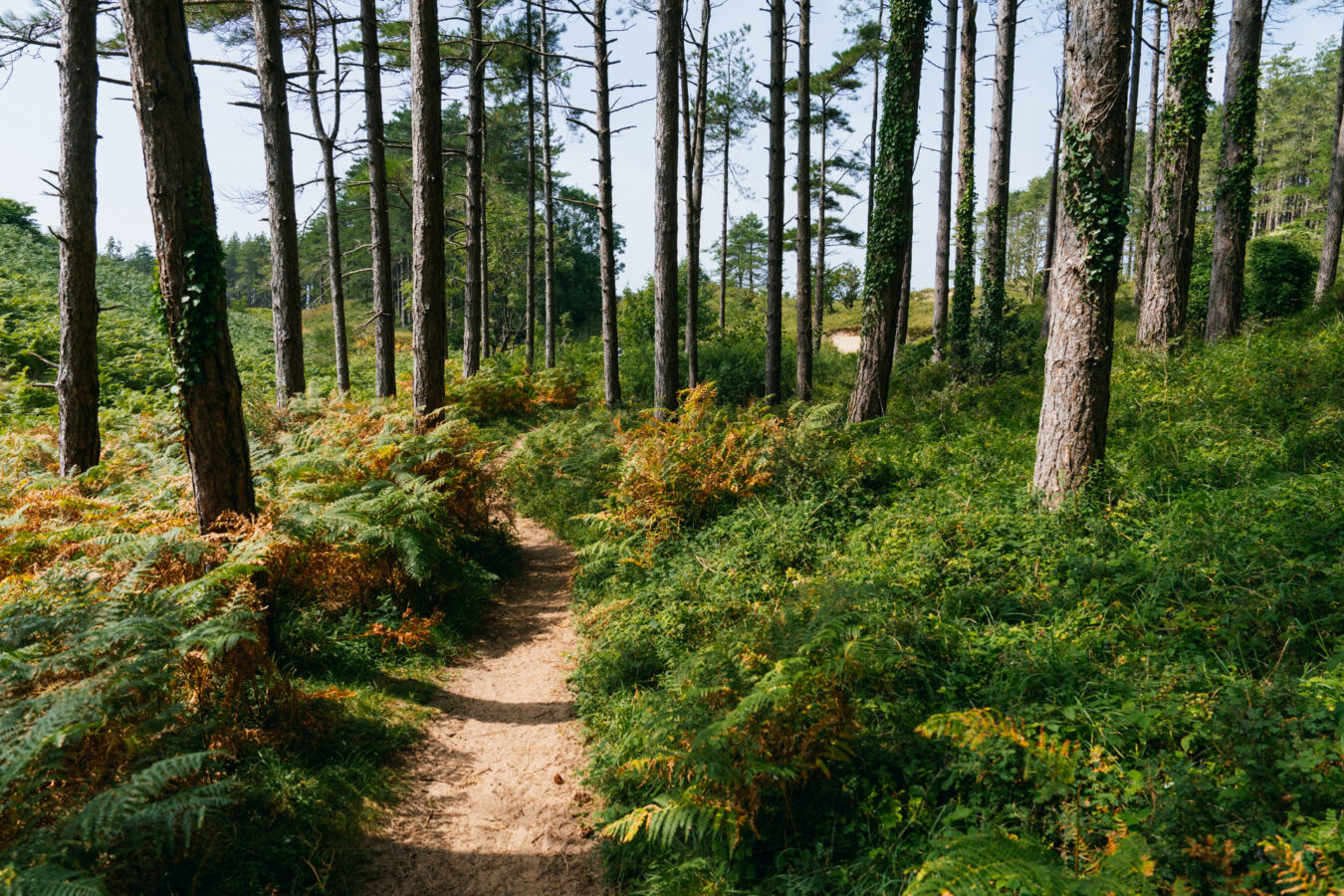
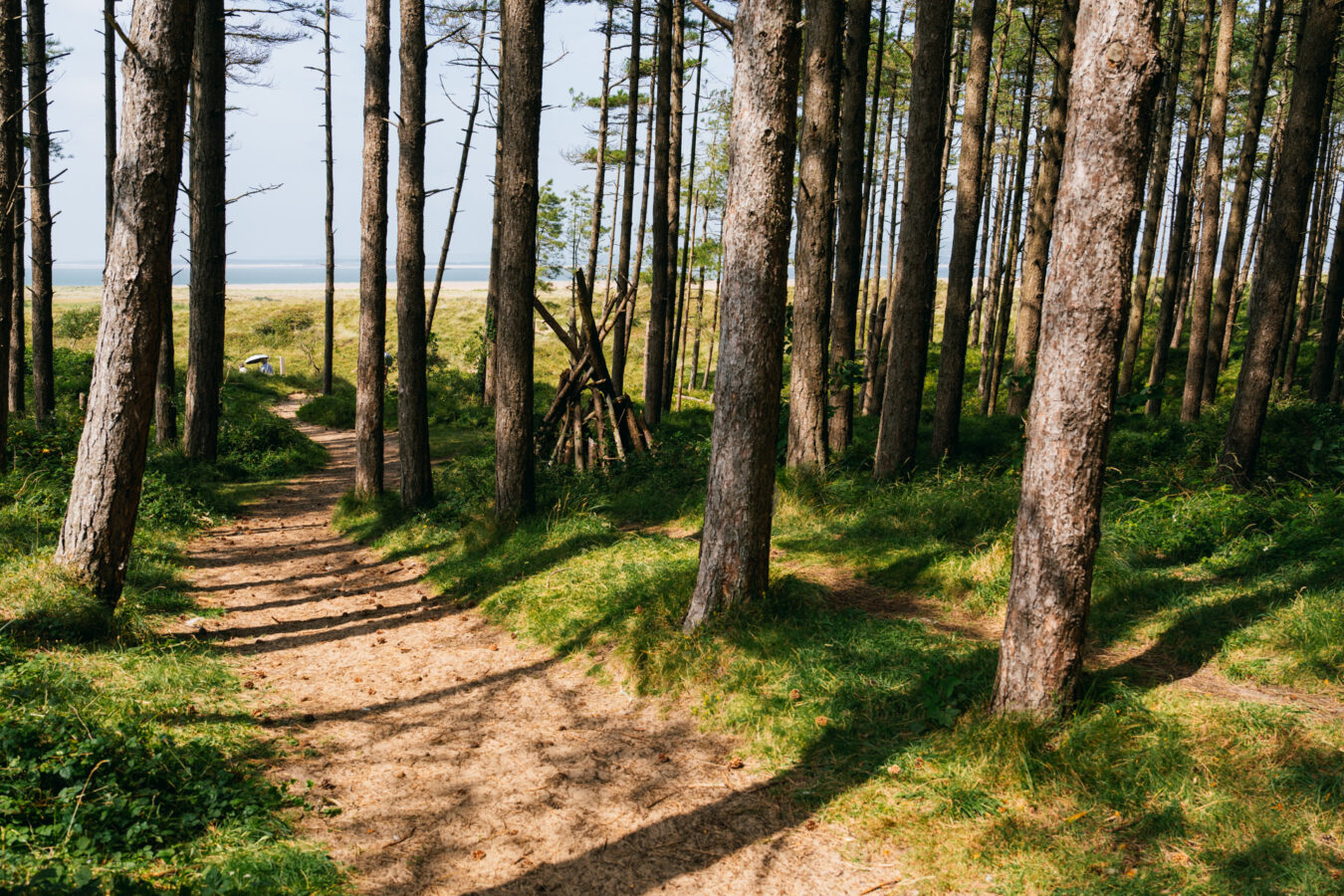
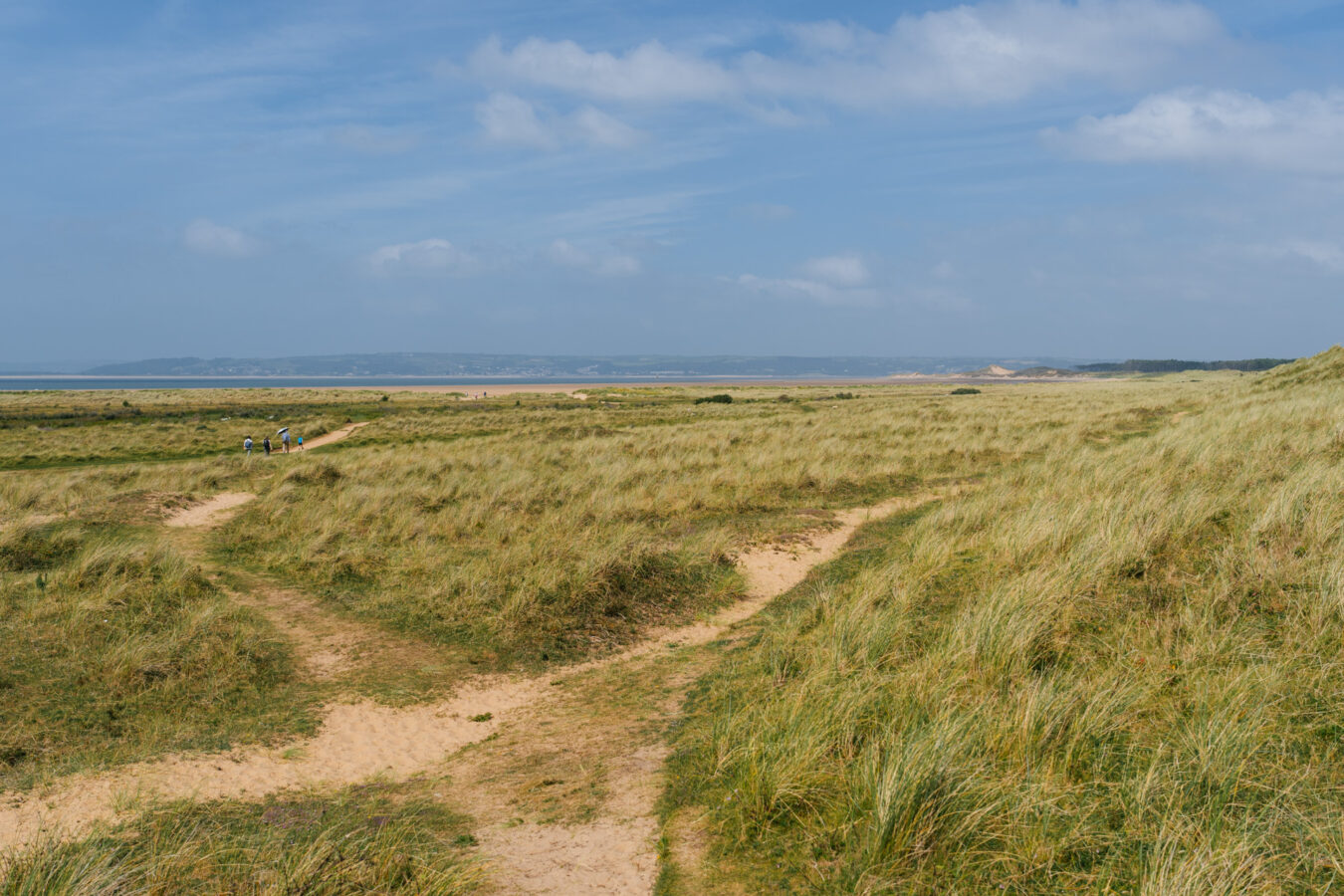
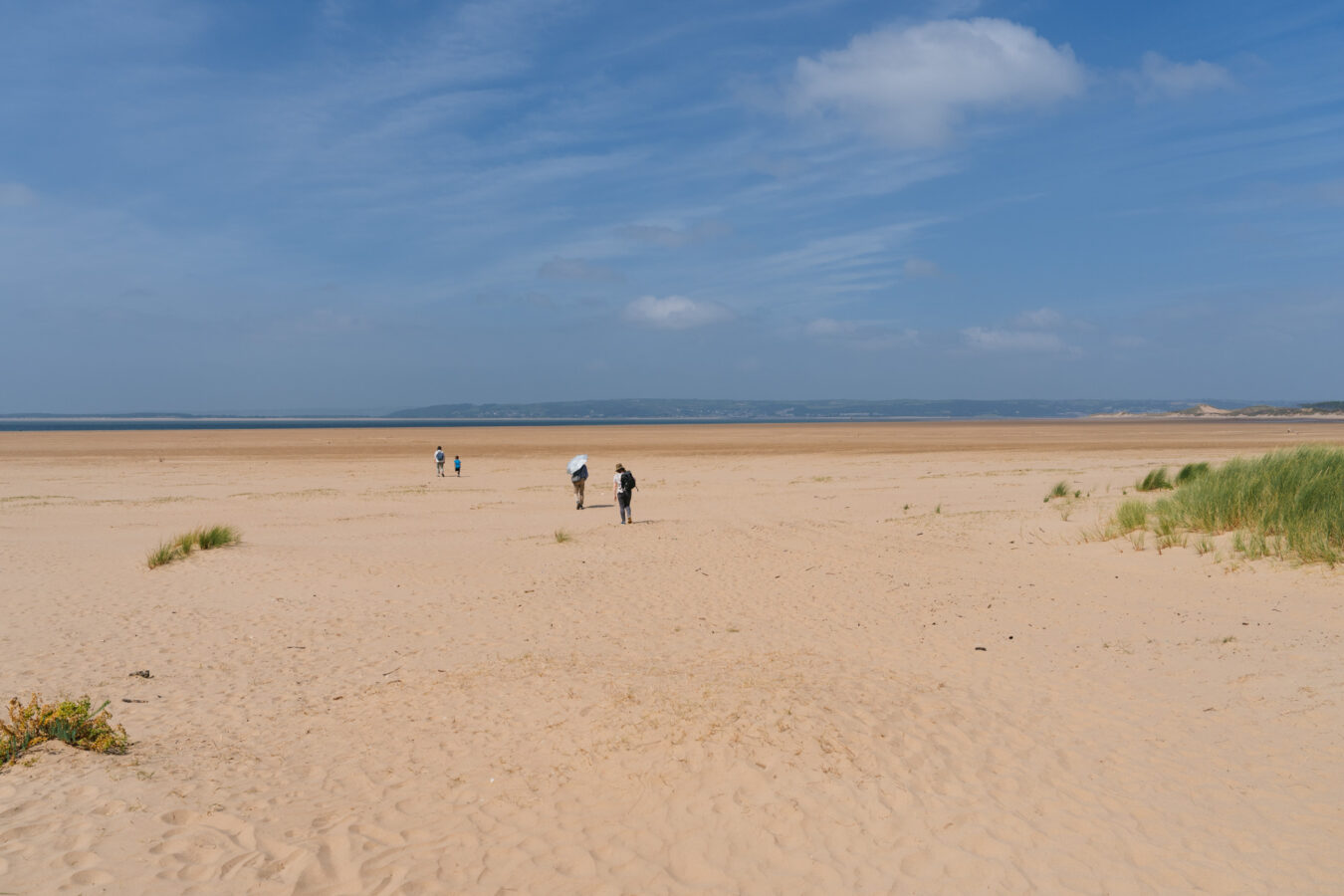

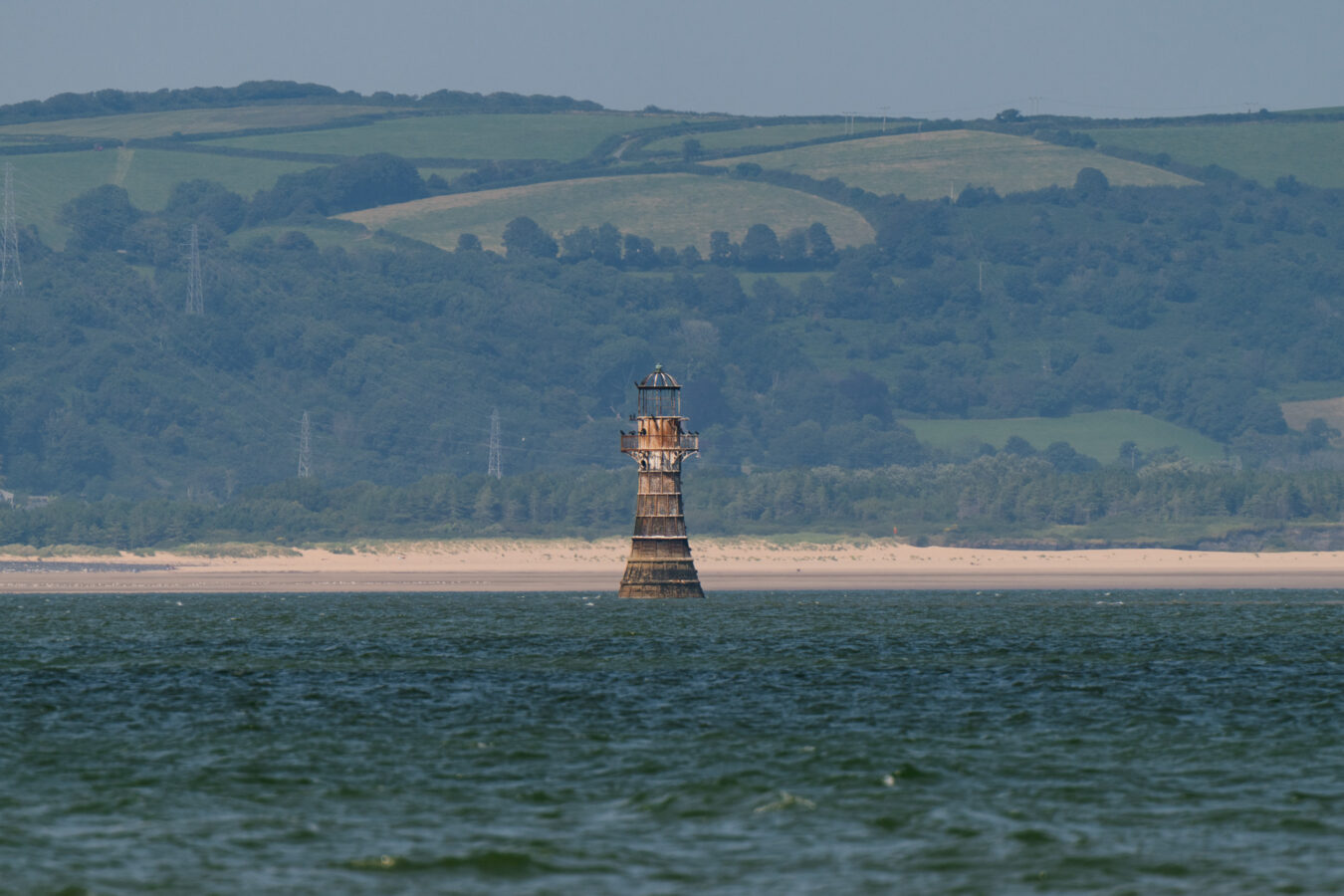
After a long walk to, around, and back from Whiteford Sands, we returned to the car and drove back to the cottage.
extra info about whiteford
Parking: The Whiteford Beach car park is located between Llanmadoc and the hamlet of Cwm-Ivy. When we visited, the ticket machine was out of order, but you can pay via the Your Parking Space app.
See car park on
Google Maps | Apple Maps
Walking: From the car park, several trails lead to the beach and on to the furthest point, where the lighthouse is located. You can also do a circular walk, which takes around 90 minutes to two hours.
See Whiteford Sands circular walk on
Foothpath
Public transport: Buses 115 and 116 stop at Llanmadoc, close to the beach car park.
Dogs: Allowed on the beach all year round.
Amenities: none on the beach, closest café is 20-minute walk away in Cwm-Ivy, and there is the Britannia Inn in Llanmadoc.
Lifeguard: no patrols on the beach.
Day 5 – Clyne Gardens and Culver Hole
For our last full day at The Mumbles, we began by visiting Clyne Gardens, located just north of the town. Entry is free. This botanical garden spans over 19 acres and is renowned for its collections of Rhododendrons, Pieris and Enkianthus. It’s a tranquil and peaceful place where you can easily spend hours. Some of the most picturesque corners include the wood sculptures, the Italian Bridge, and the Japanese Bridge — unfortunately, the latter was closed due to damage and fallen trees.
See Clyne Gardens on
Google Maps | Apple Maps
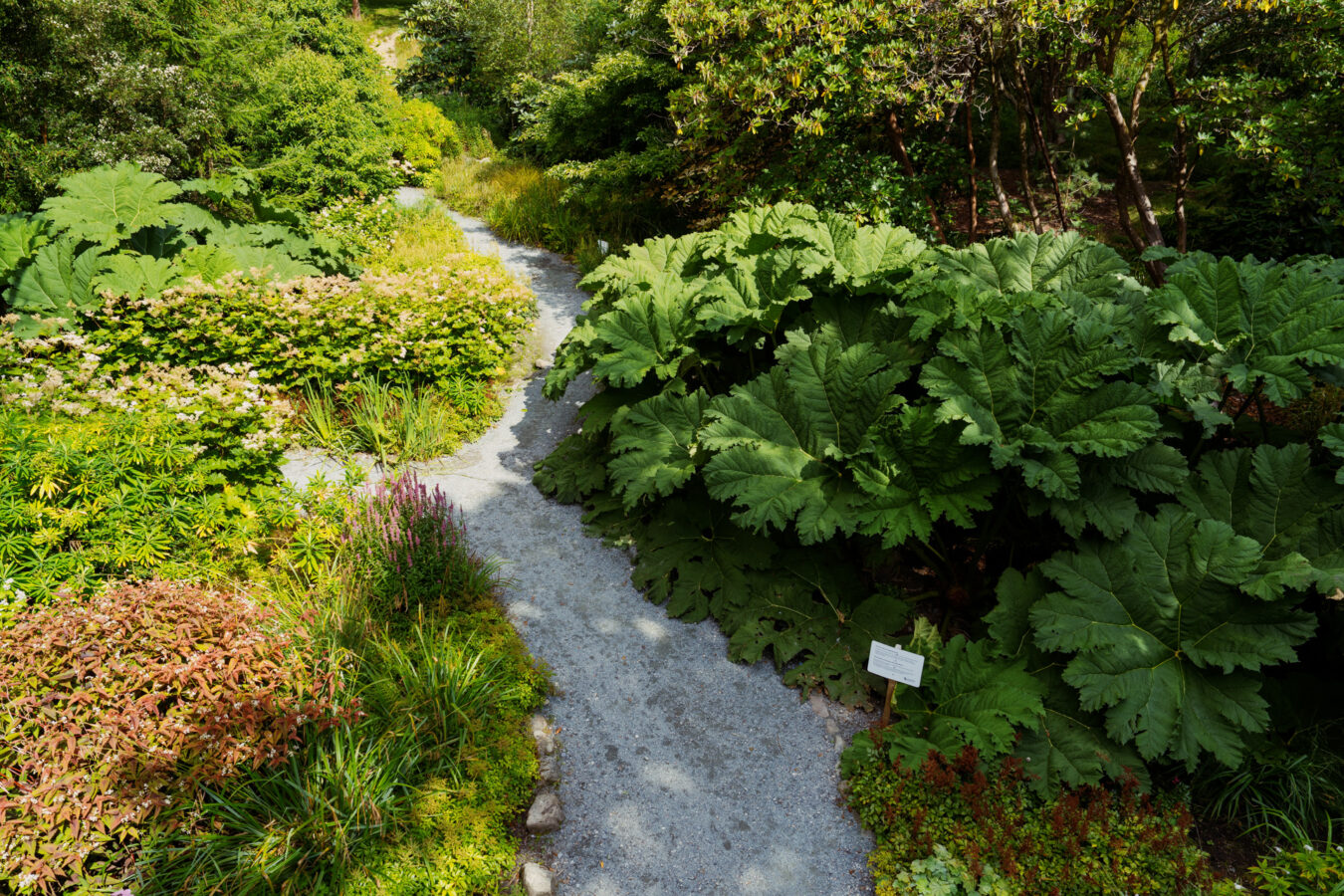

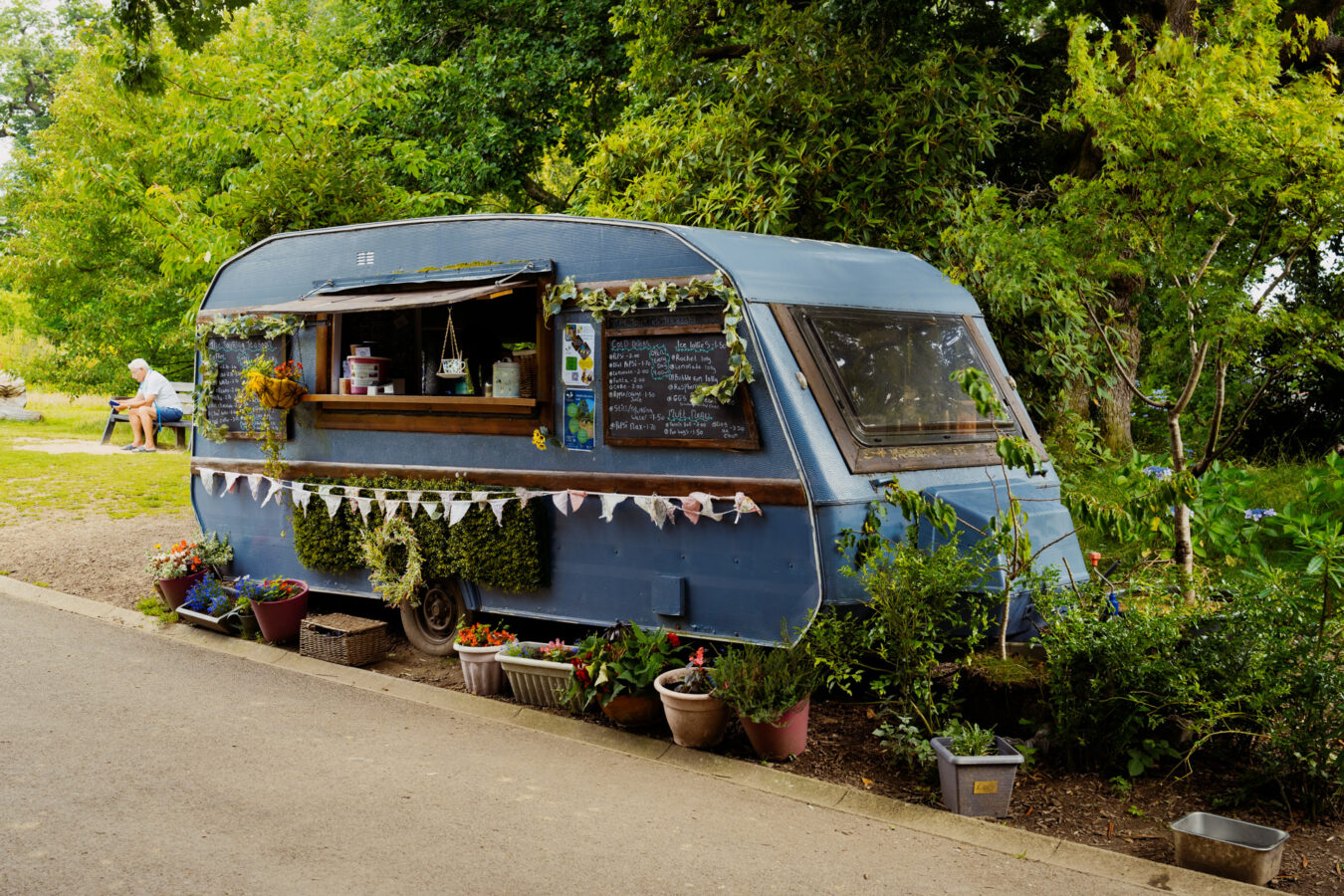

The family decided to spend the rest of the day in Mumbles, so I took the car and drove back to Port Eynon to search for Culver Hole properly. There are two ways to reach it: either via the top of the cliff and then down again, or along the beach at low tide. Either way, you will need to navigate uneven sandstone, slippery seaweed, and pebbles at some point.
I chose the cliff route, which also offers rewarding views of the coastline. After a bit of scrambling and finding the safest path to the beach, I finally reached Culver Hole. The site has many fascinating stories, including being used as a smugglers’ stronghold.

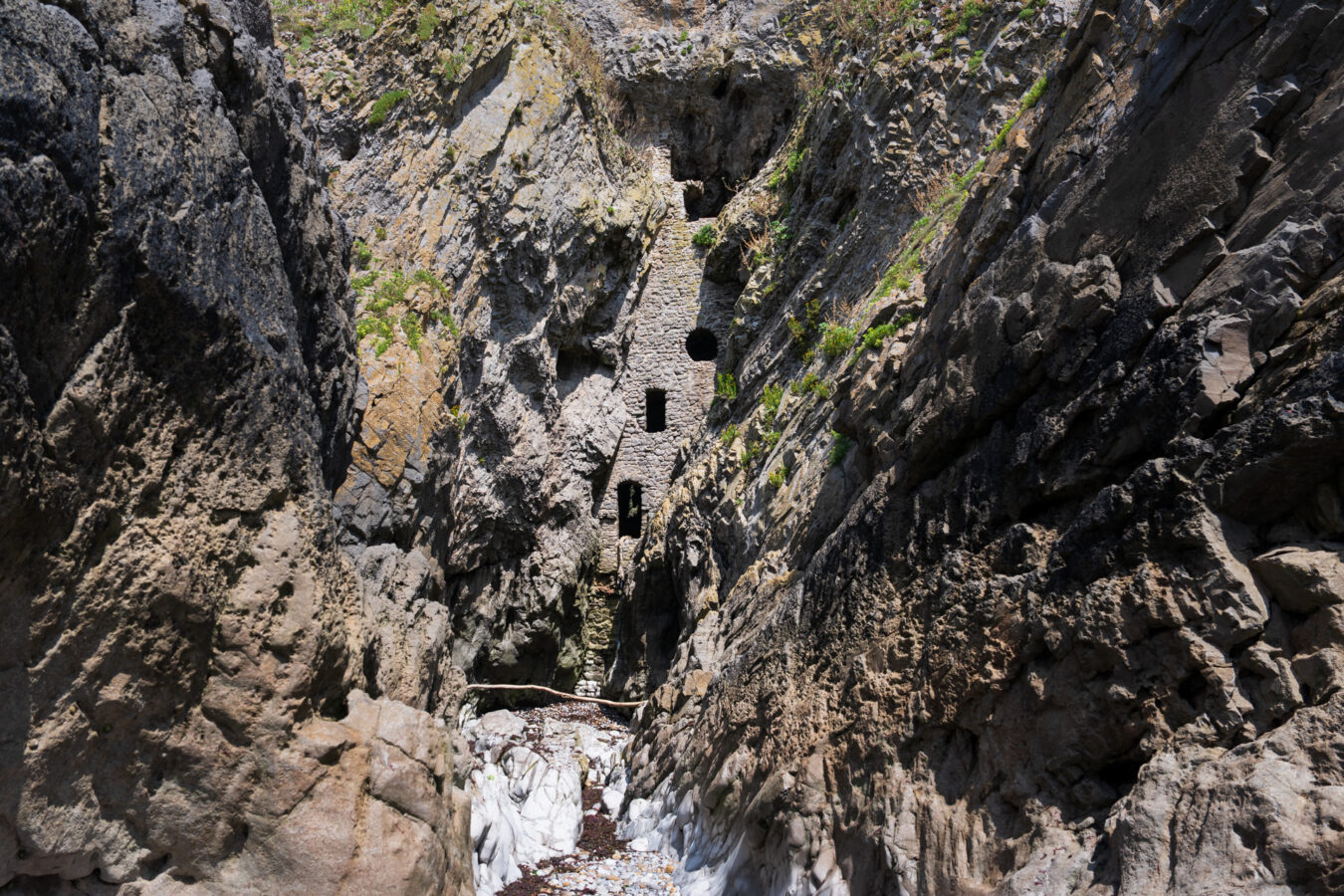
If you’re interested, I’ve written a dedicated article describing the hike to Culver Hole, with plenty of photos and all the practical information you need.
Before heading back, I decided to drive to Rhossili one last time to enjoy the views and take a walk along the northern cliffs. There are several routes to choose from in the area, ranging from shorter strolls to longer hikes, including the circular walk around the Vile, where you can see an example of restored medieval strip farming. For more information on the top trails at Rhossili, visit the National Trust website.
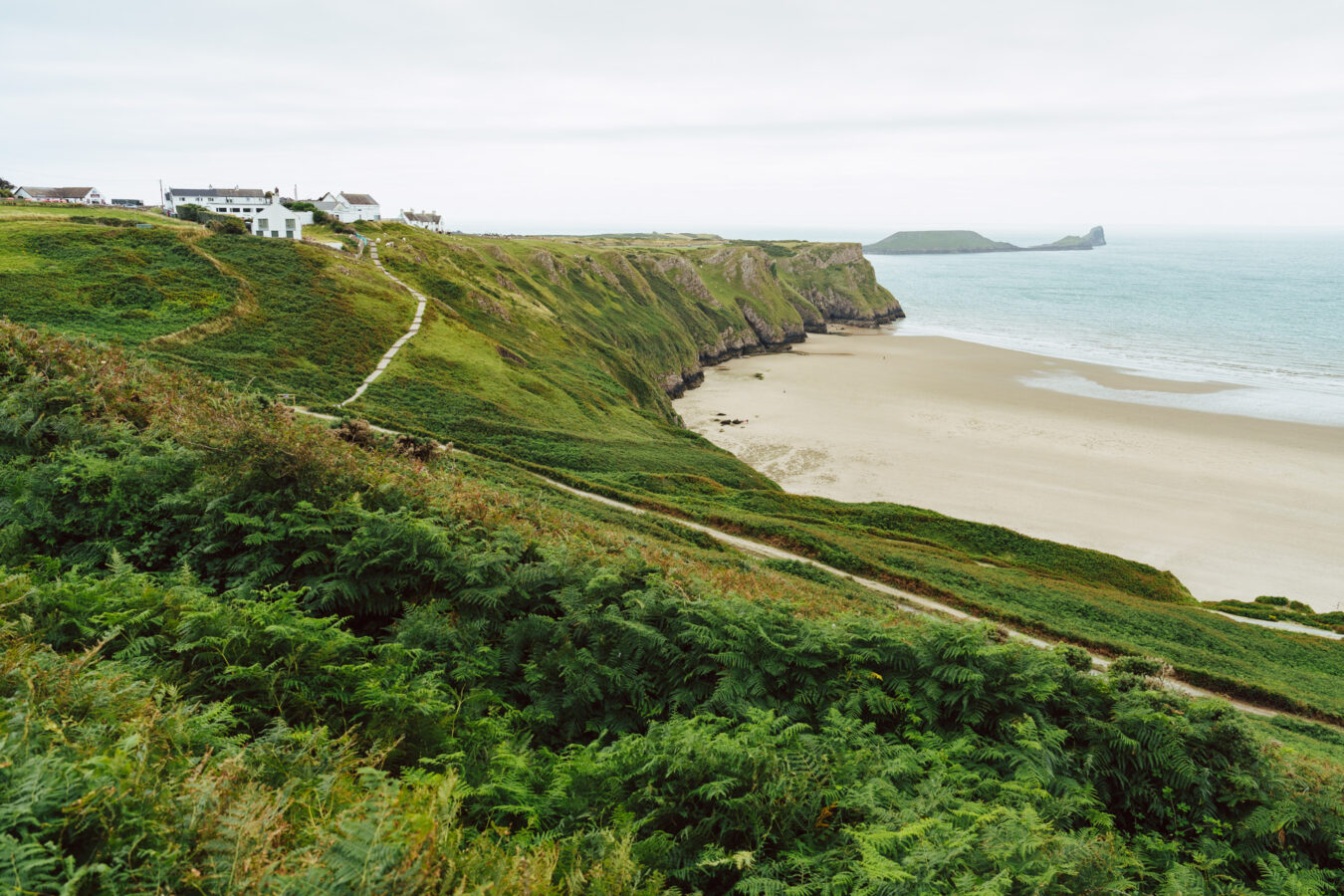

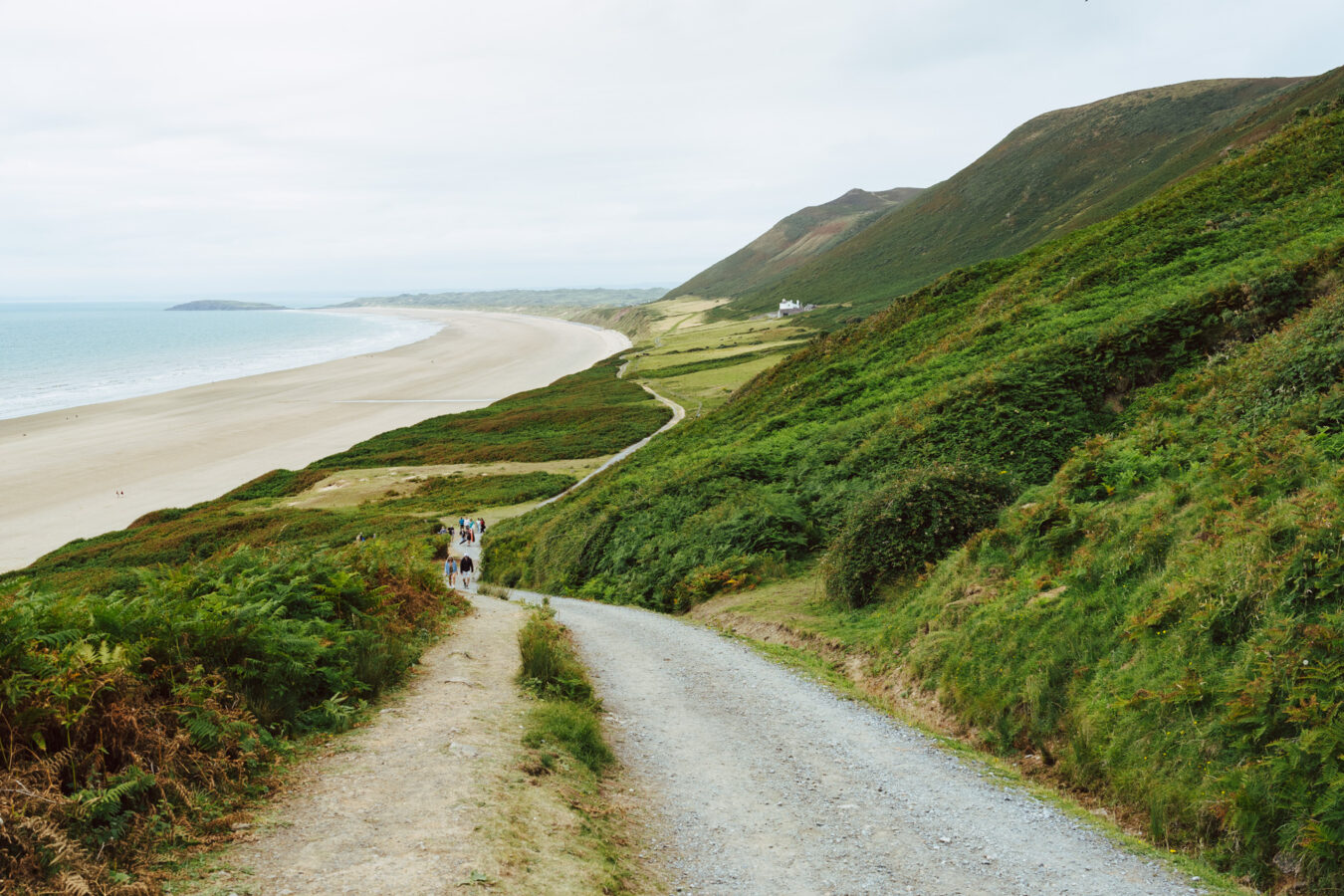

Driving Back Home
Our time on the Gower Peninsula was thoroughly enjoyed by everyone in the family. It offers some of the most stunning coastal scenery I’ve seen in South Wales, and with everything within relatively easy reach, it’s possible to visit several places in a single day — although having a car is essential.
The Gower also caters to a wide range of interests. If you enjoy spending a day playing and relaxing on the beach, there are plenty of choices, and you could visit a different one each day. If you prefer towns with more buzz, such as The Mumbles, or quieter spots with fewer crowds, there’s something for everyone. I’ll definitely be returning to explore even more.
Extra Information
There are plenty of accommodation options to suit every need and budget. We stayed in Mumbles, but there are also numerous cottages around the peninsula, as well as camping and caravan sites.
Public transport in and out of the Gower is mainly by bus, with train connections serving Swansea only. Buses can get you to most of the destinations mentioned in this article, but be aware that timetables are not always convenient and may require changes, sometimes with long waiting times. You can plan your journey at traveline.cymru. For more information, see our dedicated article on public transport in Wales.
Unsurprisingly, having a car makes getting around much easier. Swansea offers various car rental options, with major companies such as Europcar and Hertz operating in the area, as well as some local providers. This Google Maps list is a good starting point.
There are also taxi services available in Mumbles and Swansea.
Frequently Asked Questions
Is the Gower Peninsula worth visiting?
Yes, absolutely — it’s one of the most beautiful places in South Wales, with iconic scenery and unique attractions such as Rhossili, the sunflower fields, hidden coves, and more.
What is the prettiest part of the Gower Peninsula?
Beauty is in the eye of the beholder, and the truth is that many places could lay claim to the title. Personally, I found the whole of Rhossili Bay absolutely stunning and every bit as impressive as the many pictures I had seen online. Whiteford, with its more challenging access, also left a lasting impression on me.
Is the Gower the same as Mumbles?
No — Mumbles is a town on the border between Swansea and the Gower National Landscape. The Gower is much larger, encompassing the entire peninsula.
What is Gower famous for?
The Gower is known as the first area in the UK to be designated an Area of Outstanding Natural Beauty, a title it received in 1956 (it is now referred to as a National Landscape). It is also famous for its locations, including Rhossili and Three Cliffs Bay, which are among the most photographed spots in South Wales.

